Last updated on December 29, 2023
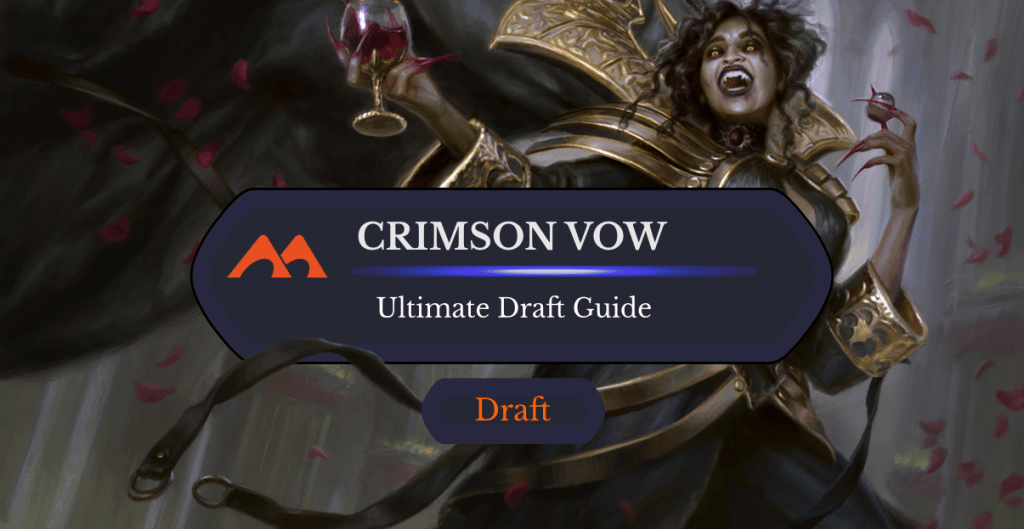
Bloodcrazed Socialite | Illustration by Marta Nael
Greetings planeswalkers! There are a number of exciting events coming up very soon, chief among them the Draft Open this weekend, that will test your prowess in Crimson Vow Draft. This guide will give you a detailed breakdown of the set’s ins and outs and should ensure you build better decks and win more games. You might even beat a Dreadfeast Demon or two!
So let’s not waste any time and just jump right in.
Mechanics
Training


Training appears exclusively in Selesnya () and only on humans. Training is an aggressive mechanic that plays best with low-curve, high-creature-density decks aided by pump spells and equipment. Haste creatures like Daybreak Combatant and Markov Waltzer also play well with training.
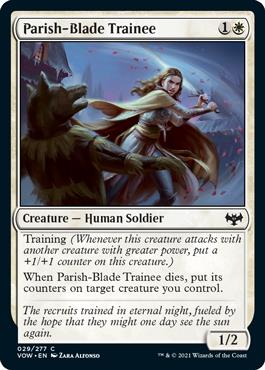
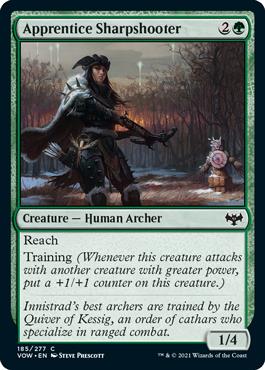

But in practice, training can also be somewhat high variance. A Parish-Blade Trainee on the play with a good follow up can attack as a 2-mana 3/4 on turn 5 or end up stuck as an embarrassing 2-mana 1/2 if your other creatures can’t help it out. Cards like Apprentice Sharpshooter and Gryff Rider play a bit better since their base stat lines are somewhat acceptable compared to Parish-Blade.
Cleave
Cleave acts as a mana sink or alternate cost for a diverse set of non-creature spells spread across all colors and primarily at higher rarities. It can be a bit confusing at first so just remember: each card with cleave is effectively 2 cards.
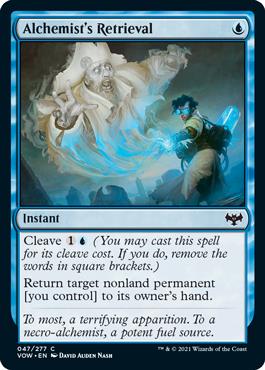
Alchemist's Retrieval is basically Rescue plus Disperse stapled together. Cleave just adds a bit of power and flexibility to a variety of utility/removal spells and is by no means a “build around” mechanic.
Blood Tokens
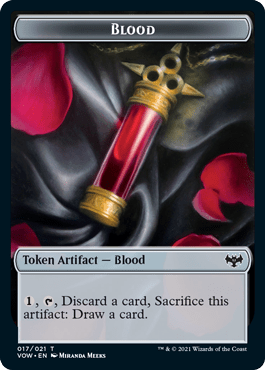
Blood tokens are the core mana-smoothing mechanic of the set and are particularly useful in longer games to pitch excess lands. They can also be of use in mana-light draws since digging for extra land early can be a lifesaver.
Blood tokens primarily appear in Rakdos () and are almost always created by vampires or as a bonus in addition to a “normal” Limited effect like Act of Treason, Painful Lesson, or Fiery Cannonade (Bloody Betrayal, Pointed Discussion, and Vampires' Vengeance respectively).
Daybound/Nightbound
This is a returning mechanic from Midnight Hunt that appears on a smaller variety of cards in this set. It’s exclusive to werewolf creatures and only appears in Gruul () while Midnight Hunt had a few exceptions like Suspicious Stowaway, Brutal Cathar, and Curse of Leeches.
Daybound/nightbound is a global effect that’s tracked for the rest of the game as soon as a card with the mechanic enters the battlefield. The basic gameplay of daybound/nightbound is that the daybound side of cards is average at best, while the nightbound side almost always offers a significant upgrade to the creature’s power level. This is Gruul’s core mechanic in Crimson Vow draft, and I’ll examine it in greater detail when I talk about the Gruul Werewolves archetype.
Disturb
Disturb is another returning mechanic from Midnight Hunt, but this time with a twist; creatures now return as auras instead of spirit creatures. This is Azorius’ () primary mechanic in draft and doesn’t appear in other colors.
Auras are an inherently proactive card type, so most disturb creatures have an aggressive lean to them. Azorius is definitely more aggressive in Crimson Vow than it was in Midnight Hunt and generally wants to tempo your opponents out with fliers, auras, and bounce/removal spells.
Exploit
Exploit is a returning mechanic that hasn’t been seen in a Standard-legal set since Dragons of Tarkir. It appears exclusively in Dimir () and only on various zombie creatures.
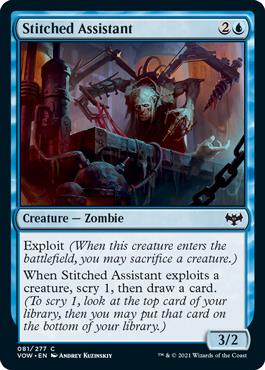
Exploit is the core of Dimir in Crimson Vow. Its main gameplay loop is to play something that wants to die like Doomed Dissenter or Persistent Specimen and then sacrifice it to an exploit creature like Stitched Assistant to put yourself up on cards. It's a generally grindy mechanic that lets you use cheap creatures for extra value but can also be awkward if its play pattern is disrupted by cards like Flame-Blessed Bolt or Circle of Confinement.
No detailed entry about the exploit mechanic would be complete without mentioning a few of its oddities. First off, a creature with exploit can sacrifice itself, which triggers whatever upside it has for exploiting a creature. Second, your opponent is given a window to respond to the trigger when a creature with exploit enters the battlefield. If they remove the creature in response to the ability, you’ll still be allowed to sacrifice a creature, but no benefit from exploit will happen if you do. This is because of a rules oddity with how exploit is worded.
Exploit is always worded “when this creature exploits a creature, do this.” The game won’t give your creature credit for exploiting anything if it isn’t around to see the sacrifice so you reap no benefits. Keep this in mind when playing with and against exploit since the mechanic can be quite exploitable if you’re paying attention.
Format Big Picture
Speed

Gift of Fangs | Illustration by Dominik Mayer
Crimson Vow hasn’t felt like an especially slow format to me, though it’s certainly not the fastest format either a la Ixalan or Amonkhet. The two most aggressive archetypes are Boros () Aggro and Selesnya () Training.
Rakdos Blood, Gruul Werewolves, Azorius Disturb, Dimir Exploit, Golgari () Butts, Orzhov () Lifegain, and Izzet () Spells are probably best described as midrange decks, though a few of them lean more aggressive. Simic () Self Mill is basically the only archetype with an explicitly durdly game plan so don’t expect your average game of Crimson Vow Limited to go on for 15+ turns.
Prince or Pauper?
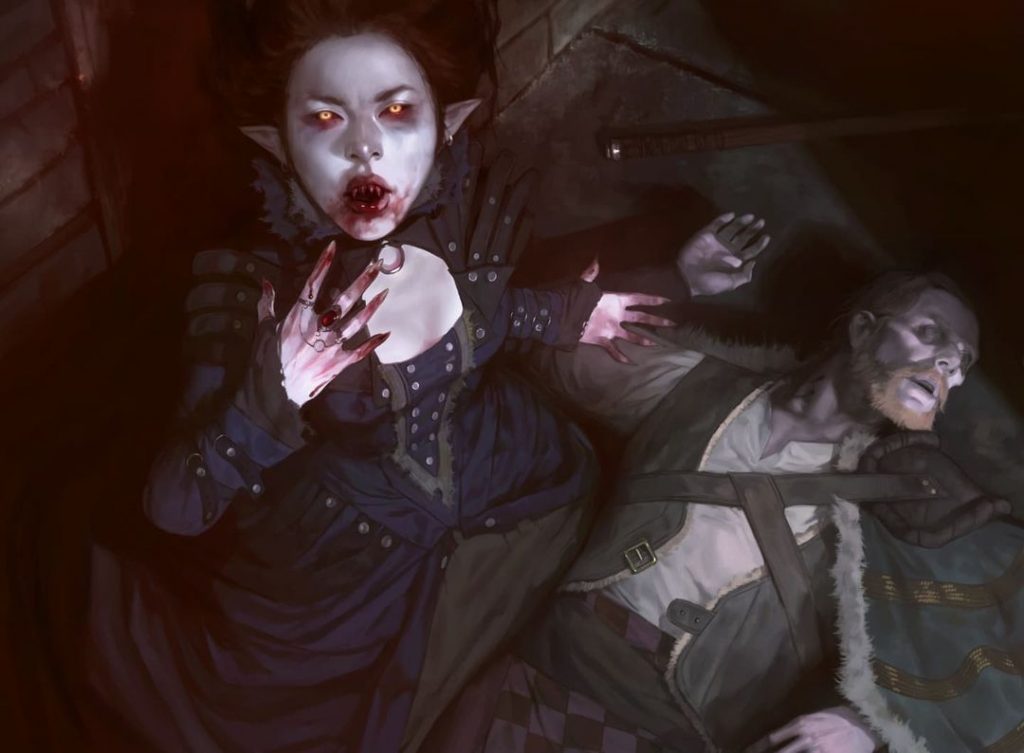
Bleed Dry | Illustration by Jodie Muir
One concept developed by the Limited MTG community to evaluate formats is to describe a format as a “prince format” or a “pauper format.” If you’re not familiar with the terminology, a prince format is dominated by higher rarity cards with a flat power level at common/uncommon and many unbeatable bomb rares. Cards like Glorybringer, Dream Trawler, Ethereal Absolution, etc. By contrast, a pauper format is dominated by commons because of synergy, aggression, or common and efficient answers to large threats.
If you’ve heard any of the buzz about Crimson Vow Limited online, you probably suspect that this format is definitely a prince format. Well I’m here to tell you that is 100% correct. Crimson Vow is home to Dreadfeast Demon, Avabruck Caretaker, Wedding Announcement, Hullbreaker Horror, and more. Roughly half the rares in this set are easy pack-1-pick-1 material over even the best commons and uncommons.
This isn’t necessarily something to despair over, though, because you have just as much of a chance to open these rares as your opponents do! You can also let this inform your card and sideboarding choices to maximize your chances of success.
Broken Rares
Step one in any prince set is figuring out which cards are actually worth the hype of being called “broken” or “unbeatable.” A broken rare is one that decides almost any game when it’s cast and goes unanswered or a game-ending effect with few to no good answers in the format.
You could argue about very strong rares I won’t mention here like Olivia, Crimson Bride, Edgar Markov, Anje, Maid of Dishonor), etc.) but I believe I’m covering the best of the best. One thing worth noting about Crimson Vow is that black has not only the most broken rares but also a very high density of good rares in general. Two exceptions to this are Demonic Bargain (unplayable) and Graf Reaver (playable but not great).
Dreadfeast Demon

Dreadfeast Demon is my choice for the #1 rare in the set. Unless you can answer it on your opponent’s turn before their end step, it demands two answers or the game is going to end very, very quickly.
It also adds two well-sized defensive bodies to the board, which is usually enough to stabilize you even if you’re behind. Just an absurd card and well worth being black for.
Avabruck Caretaker / Hollowhenge Huntmaster
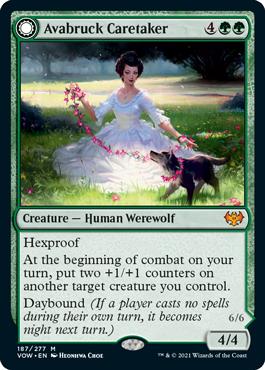
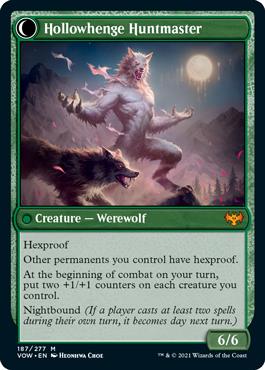
Avabruck Caretaker isn’t actually the most powerful rare on raw output, at least not on its front side, but hexproof is a miserable mechanic on something with as much power as this. Caretaker is almost impossible to match in a board stall but also has decent immediate impact.
Be prepared to hear audible groans and possibly your opponent’s life story/deepest regrets if you’re playing this in person.
Toxrill, the Corrosive
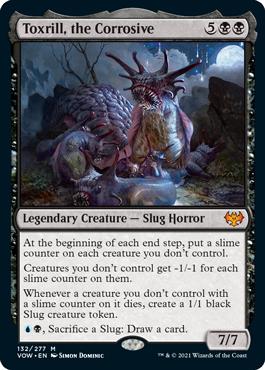
Toxrill, the Corrosive is probably the highest output rare in the set. The game is over if your opponent can’t answer Toxrill. Period.
However, unlike Demon or Caretaker a single Grisly Ritual could actually save your opponent from this monster. Still, “kill this or I win” is a good deal for 7 mana, particularly given that it can immediately kill quality X/1s like Traveling Minister. Pair this with a Blood Fountain or two for best results.
Hullbreaker Horror

Hullbreaker Horror is the rare that stands the best chance of beating up on other broken rares, provided it doesn’t get immediately hit with Valorous Stance, Fierce Retribution, or Bleed Dry.
Free bounces on each spell cast is an absurd line of text in general, but especially absurd on a flash 7/8 that will likely eat a creature if your opponent doesn’t see it coming. Beware of seven open mana if your opponent has !
Henrika Domnathi / Henrika, Infernal Seer
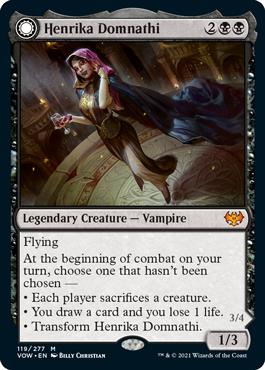
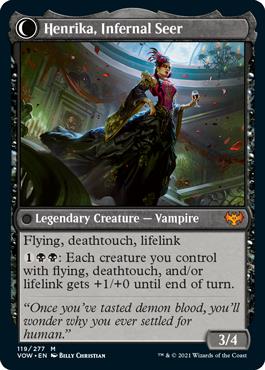
Henrika Domnathi can immediately replace itself and then either edict or upgrade into a souped up Vampire Nighthawk. This is an absurd steal for four mana, particularly alongside cards like Blood Fountain and Courier Bat which let you replay Henrika over and over.
Halana and Alena, Partners
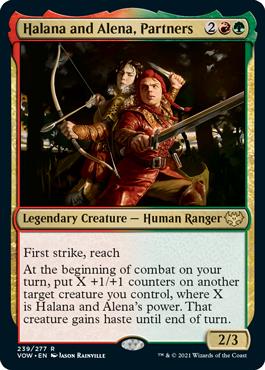
Halana and Alena, Partners is another ridiculously high-impact 4-drop. It immediately gets value as long as you have another creature and just keeps piling on the value each turn, even giving new creatures haste to boot.
And that’s without even mentioning how much better it becomes if you can pump it a bit! This is a silly card and a very common splash.
Cemetery Desecrator
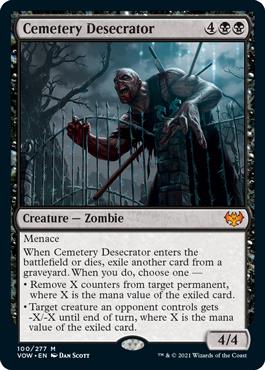
Cemetery Desecrator is easily the best of its cycle and basically acts as a giant menace Nekrataal with an extra trigger on death. The only restriction here is that you sometimes might not have the right costs in either graveyard to kill larger things, but this is still usually a walking 3-for-1 and thus a broken rare.
Wedding Announcement / Wedding Festivity

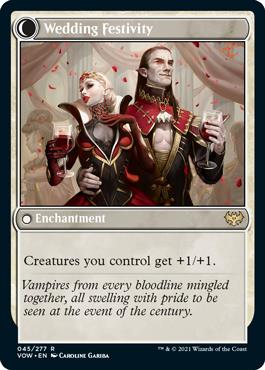
Wedding Announcement is the most humble looking of all broken rares, but don’t be deceived by appearances. This is three 1/1s plus a Glorious Anthem at worst, and it can often be much better if you aren’t behind.
You’re also afforded some flexibility in whether you’d prefer a card or a 1/1 that later becomes a 2/2 before the card transforms into Wedding Festivity.
Sorin the Mirthless
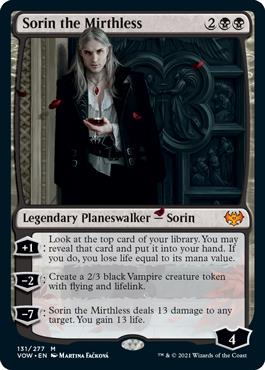
Sorin the Mirthless is much, much better in Limited than the other planeswalkers in the set. +1 is no frills card advantage and -2 creates a creature solid enough that I’d have been willing to pay for just it! Bomb planeswalkers are nothing new for Limited veterans so what’s most remarkable about Sorin to me is that it isn’t in the top 5 rares of the set!
Glorious Sunrise

Glorious Sunrise is a bit slow to get going but it’s powerful, versatile, and difficult to interact with in game 1. Card draw is generally the best option at parity, +1/+1 is for closing games, lifegain is the best mode when you’re behind, and the mana mode is rarely used but could be useful after drawing a bunch of cards off it.
Your options for blowing this up are Sanctify, Crushing Canopy… and that’s it. You’re otherwise limited to countering it on the stack or bouncing it with blue cards.
Adjusting to Broken Rares
While there’s no surefire way to guarantee that you won’t lose to Avabruck Caretaker, I can at least give you my best tips for success:
- Hard removal spells like Bleed Dry, Fierce Retribution, and Hero's Downfall are much better than normal. Most of this set’s strong rares are actually very killable, including absurd ones like Hullbreaker Horror and Toxrill, the Corrosive. A deck of cheap creatures plus some good removal always has a fighting chance.
- Crimson Vow has a lot of playable counterspells. Syncopate and Syphon Essence are commons and playable in any blue deck, either game 1 or as a sideboard measure against clunky but powerful cards. Wash Away and Geistlight Snare also exist with Wash Away basically just being Cancel and Snare being generally appealing in Azorius decks where the double discount is realistic. Counterspells can always answer expensive rares in theory, but other pressures and drawing them too late can be an issue in practice. The best way to balance this is to pressure your opponent if you can and play other instants like Scattered Thoughts and Abrade to keep them guessing and not waste your mana.
- Discard is slow and high variance (your opponent might not have the card you wanted to take or you could draw the discard spell after they cast it), but it’s better than nothing. Dread Fugue and Concealing Curtains are your only options for targeted discard while Aim for the Head is your standard common Mind Rot effect. It’s worth noting that Aim is particularly valuable against 7-drops since your opponent has to spend seven cards (as lands) to even be able to cast their rare. This plus other spells that may play can naturally lead to a turn 6 Mind Rot taking their rare before they can cast it.
- Proactivity is a good plan for formats where a lot of the worst cards you can face cost seven mana. An opponent who’s dead on board the turn they play their Avabruck Caretaker may as well be casting a Colossal Dreadmaw, after all! This kind of thinking defines decks like Boros Aggro, which is all about getting off to a fast start and then using fliers to finish the job.
Removal
Removal is a key ingredient for the pie that is Limited Magic, particularly in formats dominated by absurdly powerful creatures. Understanding what removal exists for certain cards is essential to win games in Crimson Vow Limited.
White
White has great removal in this set with two good options at common and several strong uncommons as well.
Fierce Retribution
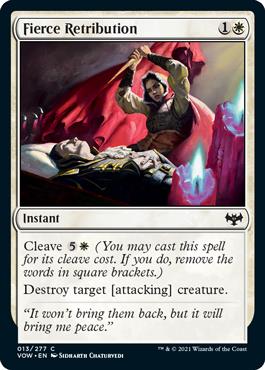
Fierce Retribution played better than I expected since two mana isn’t a ton to hold up and a lot of white decks are good at forcing races with evasive creatures. This is best in controlling decks where the drawback is the smallest, but I still like a copy in just about anything.
Sigarda's Imprisonment
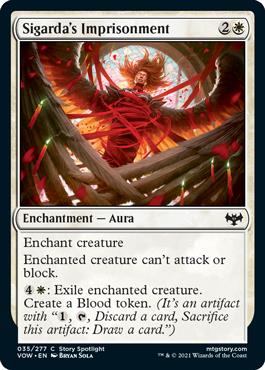
Sigarda's Imprisonment is like a 3-mana Pacifism with a small upside since you can pay five mana to permanently remove a creature and get a Blood token. I initially had Imprisonment over Fierce Retribution because I figured taking out a blocker would be valuable, but I prefer Retribution since exploit is a problem for Imprisonment. I’m happy to start a copy or two of this but board it out against Dimir Exploit, and I’d likely board in additional copies against Gruul Werewolves and Golgari Butts if I had them.
Piercing Light
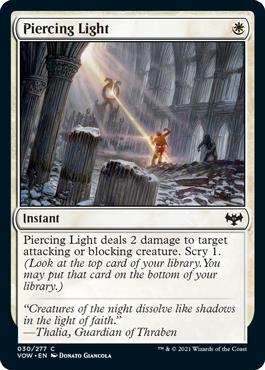
Piercing Light is cheap soft removal with a timing restriction. I rarely start it, but I find myself reaching for it against aggressive decks with lots of targets, particularly if I’m on the draw. Gift of Fangs and Flame-Blessed Bolt both also kill X/2s but are much better because of their ability to hit cards like Traveling Minister and Howlpack Piper.
Valorous Stance
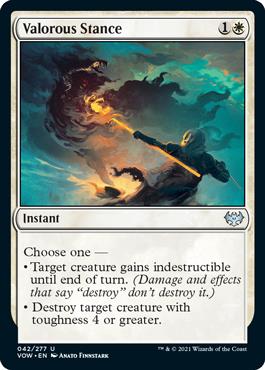
Valorous Stance hits a number of powerful rares and fat commons and doubles as a decent combat trick in a pinch. A fantastic uncommon for any white deck!
Circle of Confinement

Circle of Confinement is limited to mana values of three or less, but exile is valuable and it doesn’t have the same drawback with exploit as Sigarda's Imprisonment. Generally premium removal thanks to its efficiency, but it won’t answer most bomb rares.
Lantern Flare
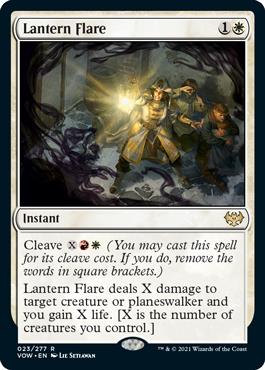
Lantern Flare is rare but functions as generally efficient removal with lifegain attached in most white decks. The cleave cost provides extra upside for when you’re flooded or in 5-color control decks.
Blue
Blue doesn’t have any hard removal with its options being limited to bounce and one -X/0 aura. Blue relies on other colors to answer threats for it.
Fear of Death

Fear of Death is somewhere between soft and hard removal It’s “harder” than Piercing Light but softer than many other options. This can make just about any creature 0 power with a tiny bit of effort, but the creature can still block and its abilities remain unchanged. This means that it’s a poor answer to cards like Bloodtithe Harvester, Child of the Pack, and Dreadfeast Demon.
This card is also a liability against exploit in the same was that Sigarda's Imprisonment is. Fear of Death is decent against aggro decks thanks to its cheap mana cost but it’s not reliable. One last oddity with it is that if you cast it on a creature with training, just about any creature your opponent attacks with will be able to grow that creature.
Alchemist's Retrieval

Alchemist's Retrieval isn’t really removal per say since any card bounced with it can just be replayed by your opponent. Still, it does temporarily answer large threats at a mana advantage while also having flexibility to rebuy your own threats in response to removal. This is a decent utility spell for any blue deck.
Lunar Rejection
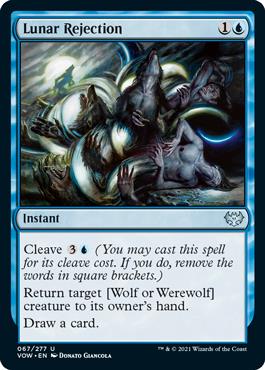
Lunar Rejection is an over-costed Alchemist's Retrieval that gives you the card back, making it a solid playable in general that shines against Werewolves when it costs .
Black
Black has the best hard removal in the set, as you might expect. Its soft removal is pretty decent and it also has most of the best rares! You can’t really go wrong with black in Crimson Vow.
Gift of Fangs
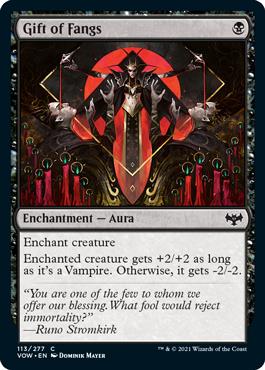
Gift of Fangs is an interesting take on Bonds of Faith that cripples non-vampires or buffs vampires. This means it misses some creatures that Flame-Blessed Bolt wouldn’t, but it still hits a good number of targets and has flexibility in Rakdos decks.
Starting one or two Gifts is fine in most decks, though I’d look at boarding them in or out depending on your opponent’s creature types.
Bleed Dry

Bleed Dry is both the best common in the set and the best common removal spell in the set. This exiles just about anything you need gone barring Unhallowed Phalanx with a counter on it. It also does so at instant speed at a reasonable mana cost, making this a frequent pack 1 pick 1 and reason to be black.
Grisly Ritual

Grisly Ritual is really, really slow. But this doesn’t make it useless since it’s a high-impact card in longer games thanks to the extra gas it provides with two Blood tokens. Most black decks could start a copy, though be advised that you should board it out against decks that don’t have expensive creatures for you to target.
Ritual plays best in Sealed or out of the sideboard against decks leaning on big expensive creatures like the dreaded Toxrill, the Corrosive.
Aim for the Head
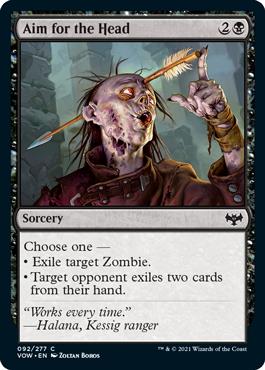
Aim for the Head is only truly removal against zombies, generally as a sideboard card brought in against Dimir. Swapping out something like Fear of Death or Sigarda's Imprisonment for this is a common switch.
Parasitic Grasp
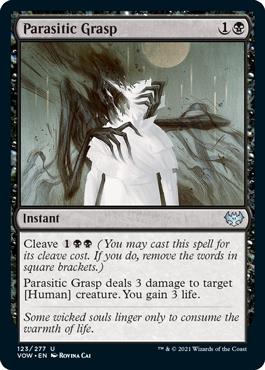
Parasitic Grasp has great bonus text against humans but you don’t need it to be good since Essence Extraction was always a strong Limited card. This is efficient removal that particularly shines against aggro decks where the lifegain is most relevant. Bonus: most aggro decks also have plenty of humans.
Hero's Downfall

Hero's Downfall is mostly just Murder, but it’s still a fantastic card even in 2021 Magic. This versus Bleed Dry is a legitimate debate since three mana versus four with exile is a close call (which I generally give to Downfall, slightly). But then again, why not play both if you can?
Red
Red has a great collection of efficient removal with a catch: it can’t do much against creatures with 5+ toughness.
Flame-Blessed Bolt

Flame-Blessed Bolt exiles anything with 2 toughness or less for one mana at instant speed. It’s a general overperformer since it has lots of relevant targets, some of which are actually powerful rares like Howlpack Piper, Headless Rider, and Voldaren Bloodcaster. Exile is also very relevant against disturb, Blood Fountain, and the like.
Abrade

Abrade is a great cheap removal spell that also happens to be a Shatter if needed. Dollhouse of Horrors is the main card you want to Abrade this way, though there are a couple of other targets like Bride's Gown, Groom's Finery, and Honeymoon Hearse. The jump to three damage catches a couple of extra cards that two damage wouldn’t, particularly a number of 3-drops.
Lacerate Flesh
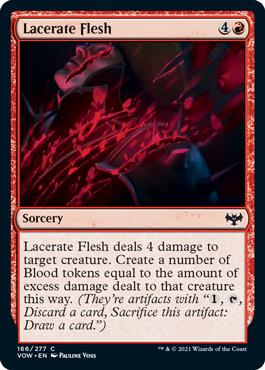
Lacerate Flesh is removal. I guess. at sorcery speed for only four damage is a pretty poor rate, but controlling variants of Izzet Spells and Rakdos Blood still might want this effect. Other decks can hopefully play better options, but I’d definitely board in extra copies against something like Volatile Arsonist if I had them.
Rending Flame

Rending Flame is very close to a Terminate in this set, and basically just misses a couple of rares, Flourishing Hunter and Unhallowed Phalanx. That's a great deal for 2R, and it even packs a small extra punch against when used against Spirits. I'd take this over Abrade and Flame-Blessed Bolt, though I don't believe there's a massive difference in power level.
Green
Green has the least amount of interaction in the set and largely leans on other colors plus Wolf Strike.
Wolf Strike
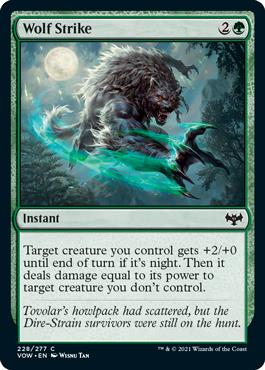
Wolf Strike is a solid Ambuscade variant that plays best in Gruul Werewolf decks or decks with Toxic Scorpion. The more daybound cards you have the more likely you’ll be able to reap the benefits of +2/0.
This card is best avoided in decks that don’t have powerful creatures, but most decks are still happy with one or two copies.
Crushing Canopy

Crushing Canopy is good removal against fliers that also covers Glorious Sunrise, Sigarda's Imprisonment, and a couple other cards. Don’t main deck this in draft unless you have enough Blood tokens to mitigate it sometimes being dead, though you should be happier main-ing a copy in Sealed).
Witch's Web

Witch's Web is a combat trick but you can sometimes play it like a removal spell if your opponent walks into it thanks to the “untap” line. It’s not always the best option, but then again neither is relying on green to answer creatures!
Sweepers
Sweepers are worth noting for any Limited format since they’re often the cards you want to play around if you’re very ahead.
End the Festivities
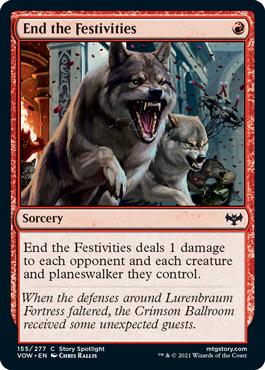
End the Festivities is a sweeper… for X/1s. This is purely a sideboard card mostly against Boros decks that show you an abundance of X/1s or any white deck with multiple Traveling Ministers.
Vampires' Vengeance

Vampires' Vengeance is a soft sweeper that kills all non-vampire X/2s at instant speed for 3-mana. This card plays best in Rakdos decks and often also gets sided out against them.
By Invitation Only
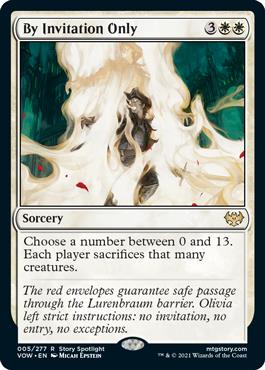
By Invitation Only is the strongest sweeper in the set and uniquely powerful in that it can actually be useful if you have more creatures than your opponent. This is a nasty one to watch out for and difficult to play around thanks to how it can punish slow rolling. Try to Syncopate it if you can!
Path of Peril
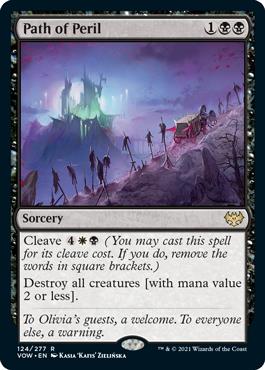
Path of Peril is pretty weak at three mana but a true Wrath of God at six mana. Generally strong in most grindy Orzhov decks or BX decks that can splash it as an Orzhov card.
Best Commons
White
Traveling Minister
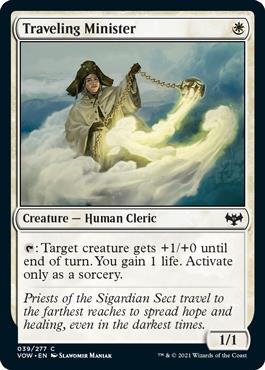
Traveling Minister looked weak to me at first but it’s a workhorse in every flavor of white in the format. Orzhov wants the cheap lifegain for payoffs, Boros and Azorius want to buff their fliers and win races, and Selesnya appreciates that it's a cheap human that helps with training.
Drogskol Infantry / Drogskol Armaments
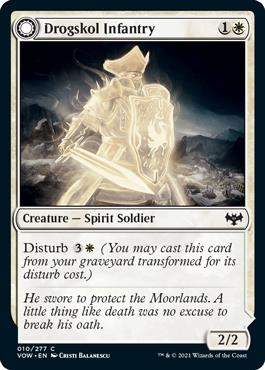
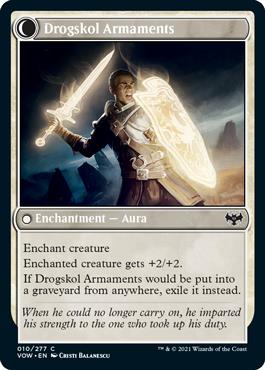
Drogskol Infantry is a very efficient common 2-drop in a format with lots of worse 2-drops. Getting a free bad aura on a 2/2 for 2 is a serious upside. This outperforms something like Vampire Slayer in any white deck 99.9% of the time.
Fierce Retribution

Kindly Ancestor / Ancestor’s Embrace

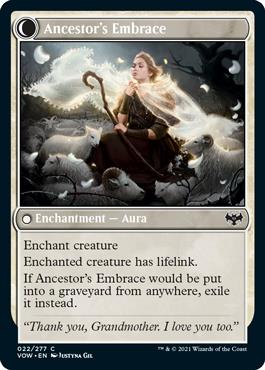
Kindly Ancestor is a beloved grandmother and efficient creature that dies into a useful aura. This particularly shines in Azorius or Orzhov build but is also a solid rate for Boros and Selesnya.
Sigarda's Imprisonment

Blue
Lantern Bearer / Lantern’s Lift
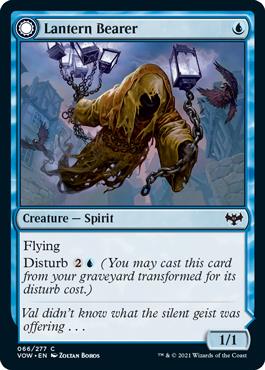
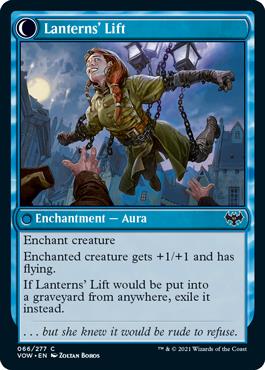
Lantern Bearer is another unassuming-looking 1-drop that has overperformed just like Traveling Minister. Simic likes milling this for free and sending Moldgraf Millipede flying, Izzet is generally scrappy and appreciates an early attacker that can chump and draw an aura for racing later, Dimir likes to sacrifice this for value, and Azorius just likes all the disturb creatures.
Cruel Witness
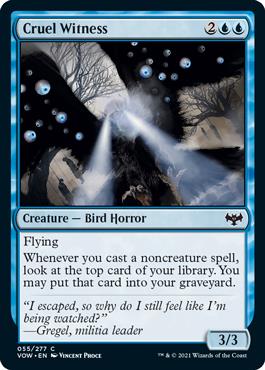
Cruel Witness is an efficient beater with only one drawback: it costs . This means that decks that aren’t base blue with 9+ Islands will struggle to cast it on time, but those that do can enjoy a Phantom Monster with upside at common.
Scattered Thoughts

Scattered Thoughts is one of the best commons in the set for value. This is a 2-for-1 at minimum that can sometimes be a virtual 3-for-1 if you can mill a disturb creature off it. It’s clunky, but playing Thoughts alongside some counterspells or instant-speed removal works wonders.
Chill of the Grave

Chill of the Grave is excellent in Izzet and Azorius since Izzet often races and wants cantrip-ing noncreature spells while Dimir has the highest density of zombies. At worst this is Crippling Chill, which isn’t a terrible floor.
Binding Geist / Spectral Binding
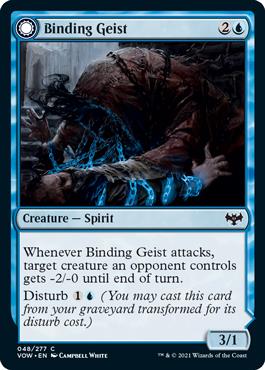
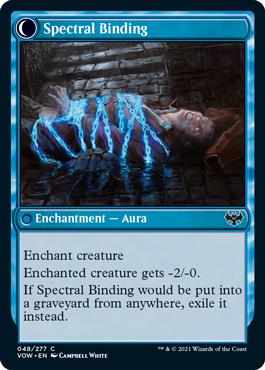
Binding Geist is solid curve-filler that trades up with most other early creatures. It’s not a sexy card but it almost always makes the cut in my blue decks.
Black
Bleed Dry

Diregraf Scavenger
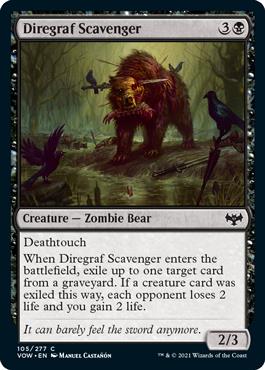
Diregraf Scavenger is an efficient creature that trades with anything, attacks well into 2/2s, and even comes with free graveyard hate and life drain. Great in any black deck!
Bloodcrazed Socialite

Bloodcrazed Socialite is more aggressive than the Scavenger but a better rate for Blood decks or decks that really want to attack. 5/5 menace for is no joke, and you’re never forced to use the ability if rummaging with Blood is more important.
Gluttonous Guest
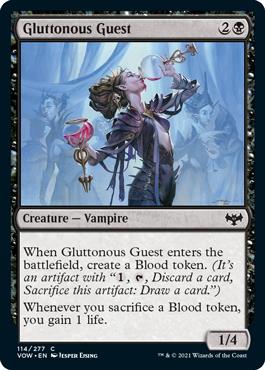
Gluttonous Guest is strong in both Orzhov and Rakdos decks since Orzhov loves incidental lifegain and Rakdos makes the most Blood tokens. This is generally a solid rate for any deck that isn’t extremely aggressive, where the Guest would be off-plan.
Gift of Fangs

Red
Abrade

Flame-Blessed Bolt

Reckless Impulse
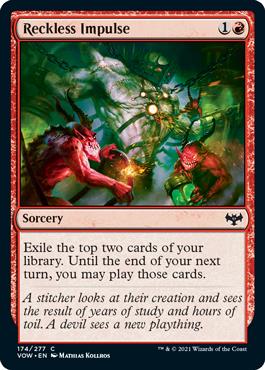
Reckless Impulse is dirt cheap card advantage, though it does play better the later you wait to cast it.
Blood Petal Celebrant
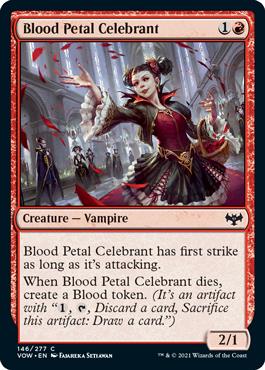
Blood Petal Celebrant is the red Drogskol Infantry as a generally efficient 2-drop that outclasses most other options.
Falkenrath Celebrants

Falkenrath Celebrants is gas. This is the best common 5-drop creature by a decent amount, but you won’t necessarily need to pick it like a top common since you only want two to four 5-drops total.
Green
Wolf Strike

Flourishing Hunter

Flourishing Hunter is an awesome curve topper for most green decks, toughness-themed or not. It’s the biggest common creature in the set and fears nothing in combat besides Toxic Scorpion and Diregraf Scavenger. The free lifegain is also a very relevant bonus.
Spore Crawler

Spore Crawler is an easy 2-for-1 that doesn’t really care what your deck is doing as long as it’s playing Forests. Good deal!
Hookhand Mariner / Riphook Raider

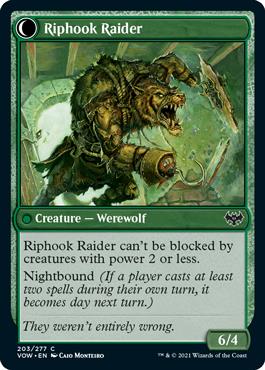
Hookhand Mariner is definitely the best common werewolf, since the front side is rather decent on its own as a 4/4 for , unlike most werewolves. Even non-werewolf decks will very rarely cut this.
Weaver of Blossoms / Blossom-Clad Werewolf
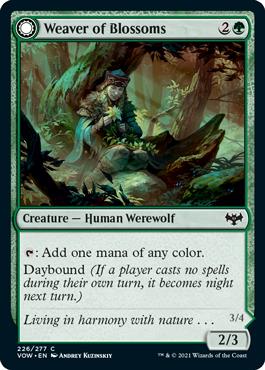
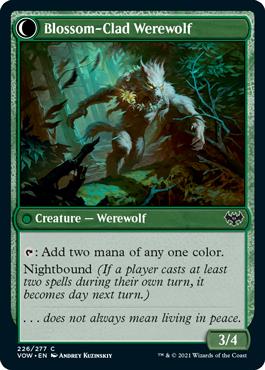
Weaver of Blossoms excels in greedy 3+-color decks, but even in a normal 2-color deck you still basically never want to cut it thanks to its reasonable stat line for a mana dork.
Mana Fixing

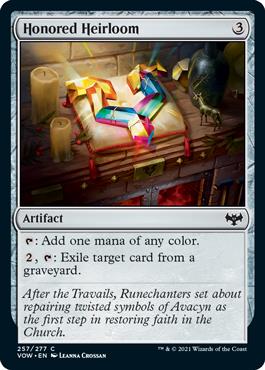

Crimson Vow is mostly a 2-color format, but solid options for splashing still exist. Colorless fixers include Evolving Wilds, Honored Heirloom, and Foreboding Statue. Wilds and Statue are generally playable in any deck even without a splash while Heirloom should be reserved for serious ramp decks greedy enough to want a glorified Manalith.

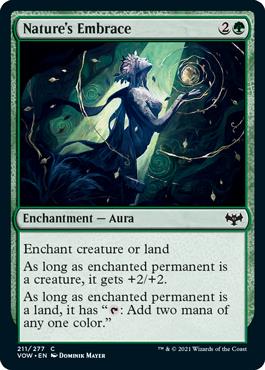
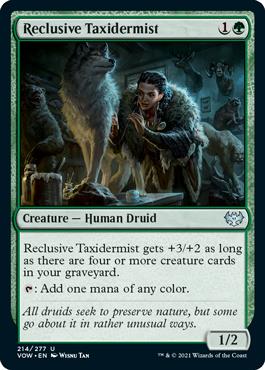

Green has several options for ramp and mana fixing as well: Weaver of Blossoms, Nature's Embrace, Reclusive Taxidermist, and Hiveheart Shaman. Weaver is a solid playable for any green deck while Embrace is mediocre and more on the Honored Heirloom side of things. Taxidermist and Hiveheart are both excellent but are higher rarity cards that will likely be taken early by other players.
Splash Heuristics
In order to splash a card in Limited, you first need to identify some kind of powerful or novel effect your deck wants but doesn’t necessarily need to have on curve. Then you need to have enough sources to manage to cast the cards in a reasonable time frame while also having enough sources of each primary color to not lose too much consistency.
Consult the table below for a second:

You’d have a 79.2% chance to cast your splashed card by turn 6 with just three sources of its color. And this is without accounting for any additional bumps you may get from having more than three sources of a color, having additional card draw like Blood tokens, etc.
You can also see eight sources of a color makes for a good minimum number: this gives you a roughly 90% chance on the play to cast 2-drops of that color. A realistic but solid Limited splash should look something like this:

This deck has eleven blue, eight red, and three green if you count Evolving Wilds and Honored Heirloom as full sources of each color. That’s maybe a bit over-generous, but I had some help from Blood tokens and Thirst for Discovery to smooth out my draws. The odds weren’t in my favor to cast Halana and Alena, Partners on turn 4, but the power level of the card more than justified its inclusion.
I've written an entire article on how to splash in limited here.
Best Cards to Splash
Removal and bombs are essentially the best cards to splash. Both classes of cards scale well over the course of the game while splashing an efficient 2-drop like Voltaic Visionary or Packsong Pup makes much less sense.
A word of caution: try not to splash anything with two colored symbols. The math is very unfriendly. Exceptions can be made in very greedy, true 3+-color decks with a lot of mana fixing or several copies of Nature's Embrace that can singlehandedly enable greedy XX splashes.
You haven’t lived until you’ve cast Hullbreaker Horror with no Islands in play!
Sideboarding in Crimson Vow
While none of this applies to BO1 ranked on MTG Arena, most other Draft events are best-of-three. BO3 dramatically improves the viability of certain obvious sideboard cards like Sanctify and Crushing Canopy while subtly improving cards like Piercing Light and Syphon Essence.
Sideboarding in Crimson Vow can be approached a number of ways, but at the most basic level your goal is always to sub out low impact cards for higher impact ones. A low impact card is one that matches up poorly against your opponent’s cards.
Here are some fictional examples to get your brain juices running:
- Against the Boros aggro player who played two Markov Waltzers in a row and ran you over, cutting Pointed Discussion and Blood Fountain for Crushing Canopy and Apprentice Sharpshooter is a sound idea.
- Against Dimir exploit, you could try trimming your Sigarda's Imprisonment and Steelclad Spirit for Syncopate and Syphon Essence to better handle your opponent’s big exploit payoffs like Diver Skaab and Rot-Tide Gargantua.
- Against a BX control deck with a Toxrill, the Corrosive, those Grisly Rituals you drafted and didn’t main deck suddenly start to look much better than your 22nd/23rd cards.
- After losing game 1 to Dollhouse of Horrors, Sanctify finally gets a chance to shine coming out of your sideboard.
You get the idea. Sideboarding is a skill that takes time to develop but having a good base of knowledge to start from is a shortcut. When in doubt, experiment and try to rationalize your decisions. Even an incorrect sideboarding decision can still illuminate which cards match up well and poorly against your opponent’s deck. Learning to effectively sideboard is one of the keys to becoming a better Limited player!
Ally Color Archetypes
Each of the five ally color supported archetypes in Crimson Vow is built around a mechanic and corresponding creature tribe. The ally color archetypes are generally better supported compared to the enemy color mechanics because even though there’s a signpost uncommon for each color pair, there are more cards at common/uncommon that line up with allied colored themes.
Rakdos Blood/Vampires
Rakdos Blood is a flexible, powerful deck that can be built in slightly different ways. It’s best described as a midrange archetype since you can punish stumbles with efficient creatures while building towards an above-average long game thanks to Blood tokens giving you extra gas later.
Best Payoffs
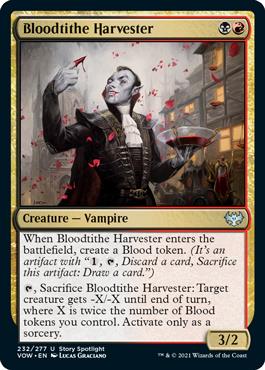
Bloodtithe Harvester is the Rakdos signpost uncommon and a wickedly efficient card no matter what your deck is trying to accomplish.
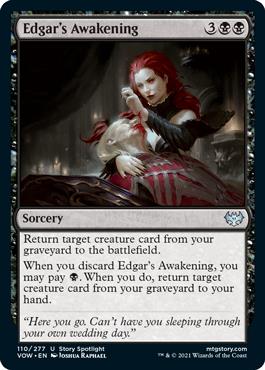
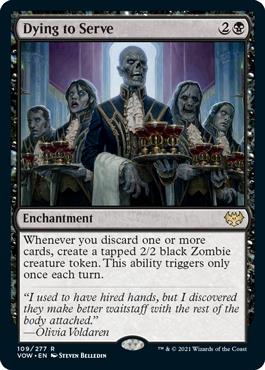
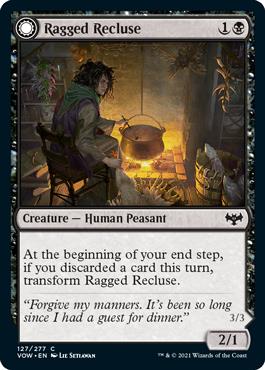
Edgar's Awakening, Dying to Serve, and Ragged Recluse all care about having frequent access to discard, which Blood tokens obviously provide.

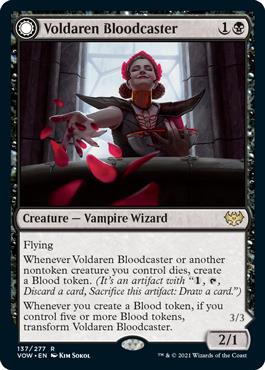

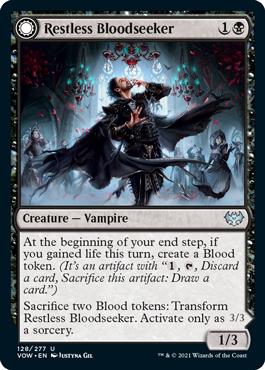
Rakdos is also best set up to leverage cards like Wedding Security, Voldaren Bloodcaster, Sanguine Statuette, and Restless Bloodseeker that reward you for having lots of Blood to work with.
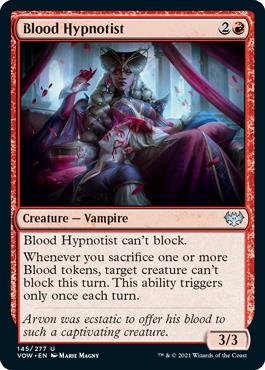
Blood Hypnotist deserves a mention as a card that some Rakdos decks love but others avoid since “can’t block” is an atrocious line of text for control decks.
Overperforming Commons


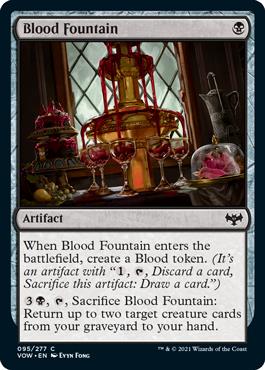
Just about anything that makes Blood tokens is good, but I caution you against playing Vampire's Kiss since it puts you down a card. Most of the best Blood-making cards are generally good commons, but Rakdos enjoys medium cards like Pointed Discussion, Grisly Ritual, and Blood Fountain more than most other decks.
Trophy Examples
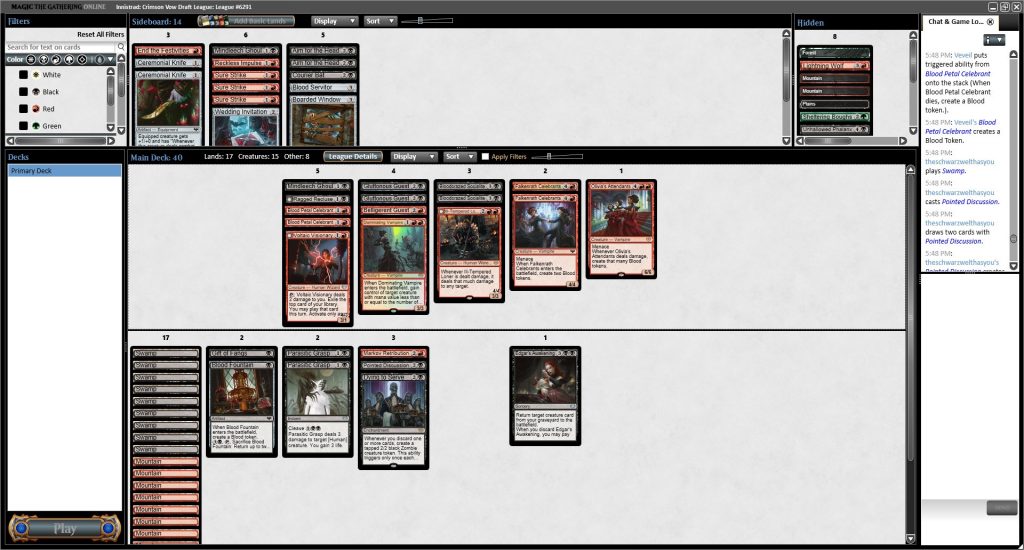
This was a midrange deck with a good mana curve, some Blood synergy and payoffs with Edgar's Awakening and Dying to Serve, and a few strong rares.
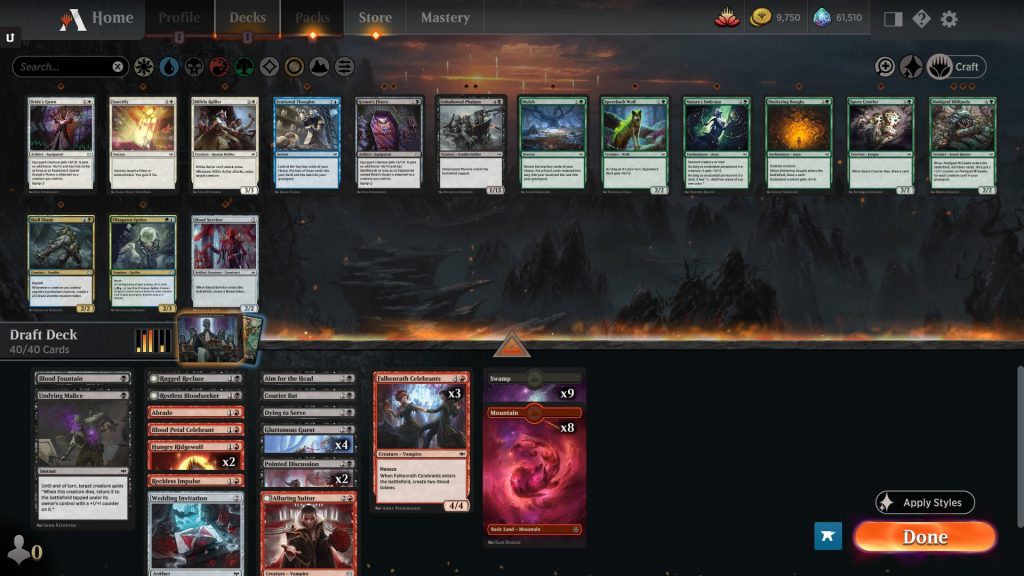
This deck was rougher and leaned heavily on Dying to Serve as a win condition for stalled boards. Gluttonous Guest and Falkenrath Celebrants were the cards that made winning with Dying possible.
Playing Against It
Your opponent’s Rakdos deck may be largely aggressive, midrange, or even controlling and just leaning on Gluttonous Guest or removal spells to buy time for whatever their game winning rare is. Honestly, there’s not that much of a difference between the decks since cards like Blood Petal Celebrant and Falkenrath Celebrants tend to be good in every version.
There’s no easy solution to the deck because of Rakdos’ tactical flexibility. Try not to get blown out by combat tricks if you have to double block menace creatures and keep in mind that Rakdos can play longer games than you might expect thanks to its abundance of Blood tokens to mitigate mana flood.
Dimir Exploit/Zombies
Dimir is a midrange deck looking to grind out value by sacrificing fodder creatures to zombies for bonuses. The key to making a good Dimir deck is balance. You want a solid mix of fodder, payoffs, and interaction to disrupt your opponent’s plans (a topic discussed more in great depth here).
Best Payoffs
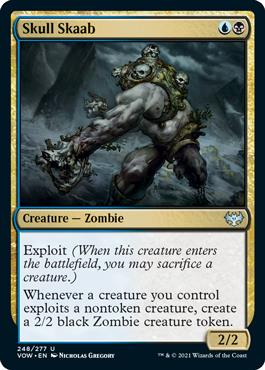
Skull Skaab is underwhelming on its own but excellent in a Dimir deck alongside other exploiters. Just be careful because sacrificing tokens won’t trigger it.
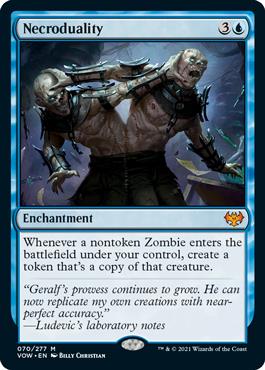
Necroduality is narrow but exceptional in Dimir since doubling up on zombies means doubling up on every single exploit creature.


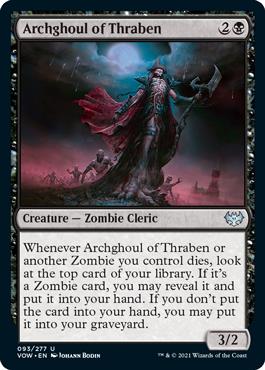
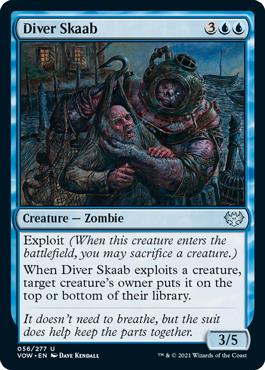
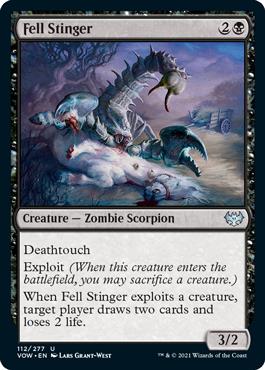
Geralf, Visionary Stitcher, Headless Rider, and Archghoul of Thraben are other strong tribal payoffs while Diver Skaab and Fell Stinger outclass the common exploit creatures on rate.
Overperforming Commons
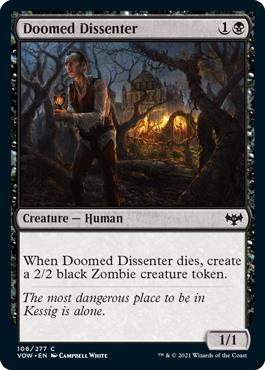

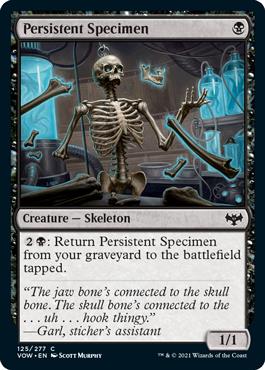
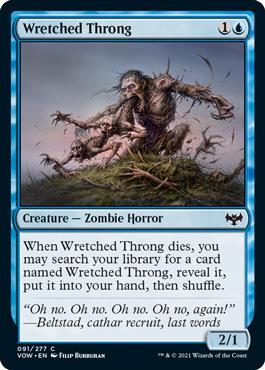
Good fodder is essential for a successful Dimir deck. Doomed Dissenter is my favorite but Lantern Bearer, Persistent Specimen, and Wretched Throng are all acceptable at two to four copies each.
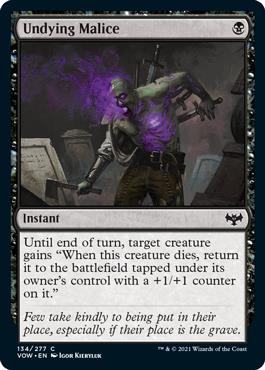
All of the exploit creatures are also good, but Repository Skaab has been iffy for me in high numbers since I can’t fit too many non-creatures in my average Dimir deck. Undying Malice is a solid one or two inclusion in most Dimir decks since it can not only be used in combat or in response to a removal spell but also in response to your own exploit trigger. You can then have the creature sacrifice itself and then immediately enter tapped and give you another window to exploit something else!
Trophy Example
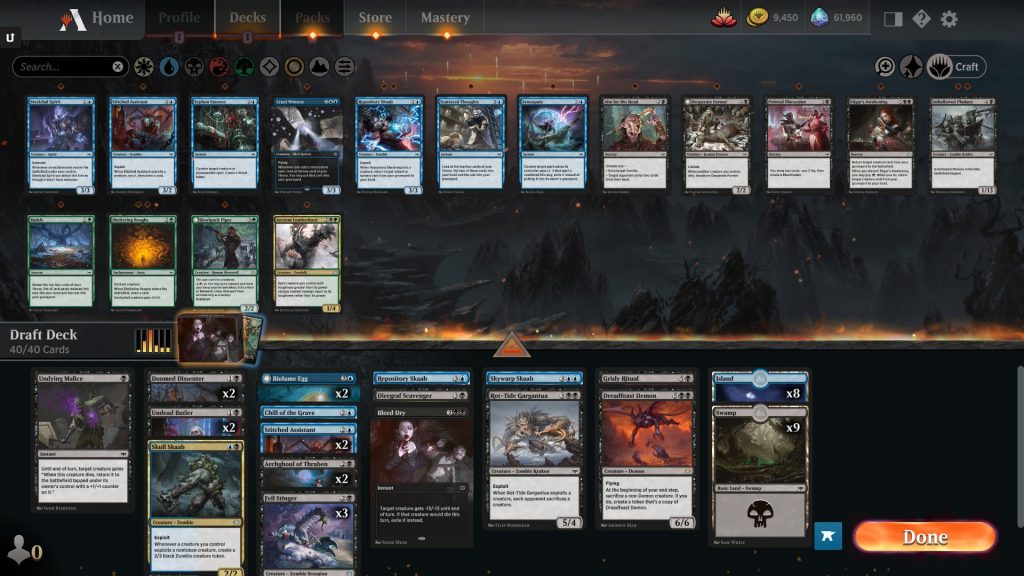
Playing Against It
Counterspells for larger exploits and cheap instant-speed removal, particularly Flame-Blessed Bolt, are the most obvious ways to disrupt Dimir’s play pattern. X/3 blockers can also be valuable against Skull Skaab since Dimir often ends up with a lot of 2/2s in play thanks to it plus Doomed Dissenter.
Covering your bases with multiple creatures larger than zombie tokens can keep you from getting overrun if you can’t directly answer Skull Skaab.
Azorius Disturb/Spirits
Azorius is a strategy with a heavy emphasis on fliers, auras, and tempo in general. It wants to whittle its opponents down and create no-win situations where racing its fliers means running through ground chump blockers that can then be equipped to said fliers.
Best Payoffs
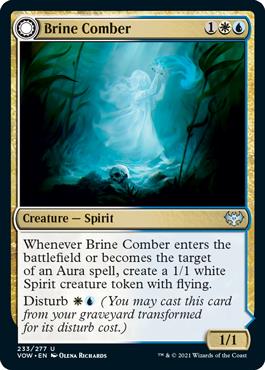
Brine Comber isn’t very powerful on its own but it’s an awesome target for auras and a great aura for your other creatures if it chump blocks. The spirit tokens it creates also wear pants well.
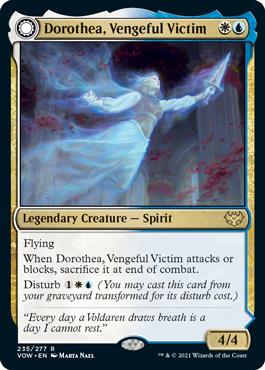

Dorothea, Vengeful Victim and Katilda, Dawnhart Martyr are premier rares for this archetype.
Overperforming Commons
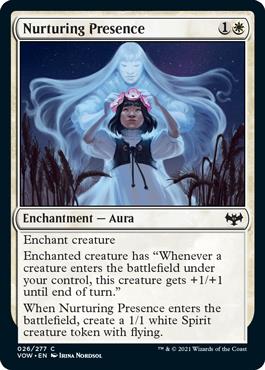
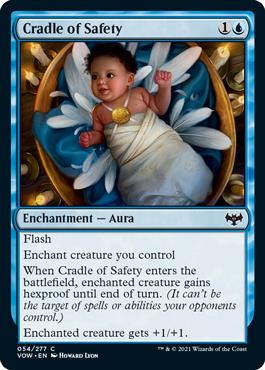
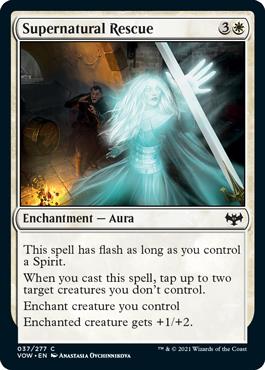
Most of the best Azorius commons are just the best blue or white commons in general, but generally weak cards like Nurturing Presence, Cradle of Safety, and even Supernatural Rescue play better in Azorius than other archetypes. When in doubt, prioritize disturb creatures since 100% of them are good in this deck.
Trophy Example
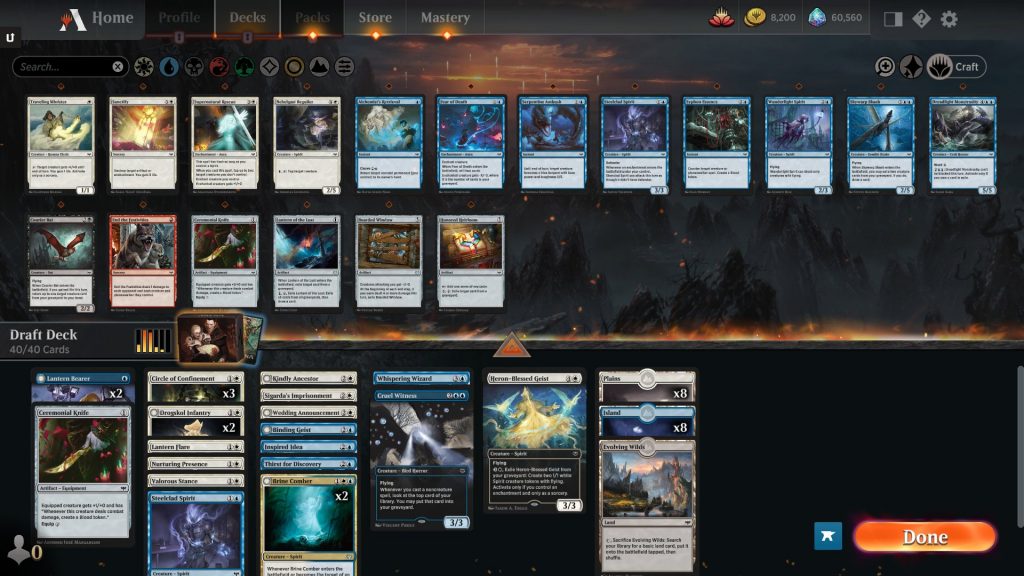
Playing Against It
Crushing Canopy and Apprentice Sharpshooter definitely come in handy against the average Azorius deck. Your approach to beating Azorius varies based on their deck’s speed. Faster decks like Boros want to go under it while BX controlling decks want to save removal spells for creatures wearing auras if possible and go over the top of Azorius.
Gruul Daybound/Werewolves
Gruul Werewolves is an aggressive-leaning midrange deck that’s a soft repeat of Midnight Hunt Gruul. Thankfully for Gruul this time around, the werewolves in the set are generally stronger and the format is less hostile towards large creatures.
Gruul wants to curve out with wolves and werewolves before eventually passing the turn and hopefully untapping with an army of killer doggos.
Best Payoffs
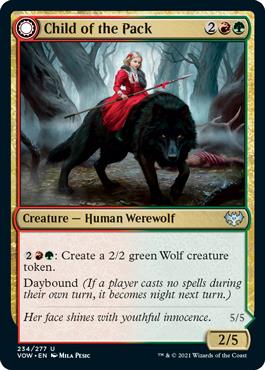

Child of the Pack is an amazing signpost uncommon for Gruul. It seems like a fine blocker that spits out 2/2s late game on its own, but it plays much better than it looks thanks to how the day/night mechanic works. This card provides the perfect excuse that Gruul is looking for to pass the turn for night without wasting mana thanks to its handy activated ability.
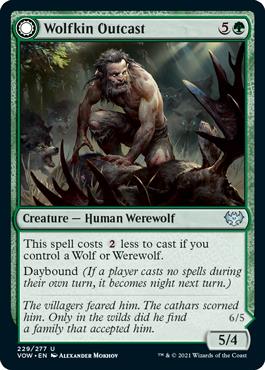
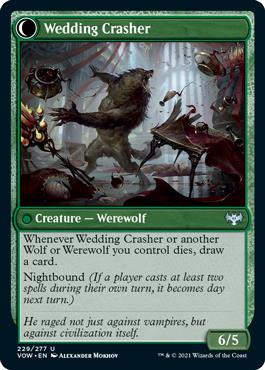
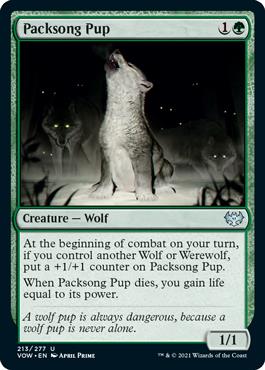
Some other excellent payoffs for being Gruul are Wolfkin Outcast and Packsong Pup. Gruul has a number of bomb rares that happen to be werewolves if you’re lucky enough to open or get passed any of them.

Into the Night is clunky but deserves a mention as the only way to force night besides passing the turn. I wouldn’t run it without at least five good werewolves but I’ve definitely died to the card before.
Overperforming Commons





Wolf Strike, Hookhand Mariner, and Weaver of Blossoms were mentioned as solid green commons but are even better in Gruul than normal.


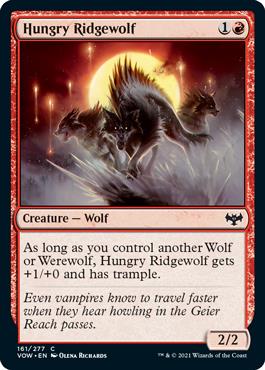
Snarling Wolf (particularly alongside Packsong Pup for the dream curve), Sporeback Wolf, and Hungry Ridgewolf also overperform in Gruul. On the other hand, medium wolves and werewolves like Fearful Villager and Lightning Wolf are certainly playable but shouldn’t be prioritized even in Gruul.
Trophy Example
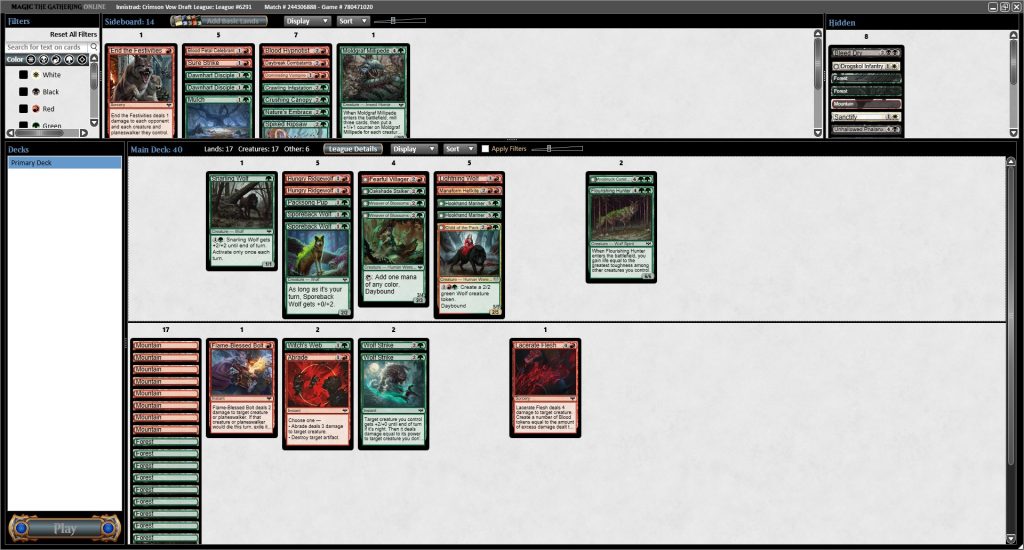
Playing Against It
Try to conserve cheap spells if you can heading into the mid- to late-game since you don’t want to be caught with your pants down at night. Deathtouch-ers and spot removal over perform against Gruul. Counterspells are dangerous against werewolves; you can catch some solid beaters with it but passing the turn for it also plays right into Gruul’s paws.
Selesnya Training/Humans
Selesnya is an aggressive deck in this format with a number of small themes: humans, +1/+1 counters, and the training mechanic. Curving out and protecting your best creatures is vital for success with Selesnya. This is my least favorite and unsuccessful of the five allied color archetypes since it tends to fail against too much removal or if it stumbles early.
Best Payoffs

Sigardian Paladin is a solid signpost uncommon that makes racing Selesnya difficult, provided you can have it train some of your other creatures.
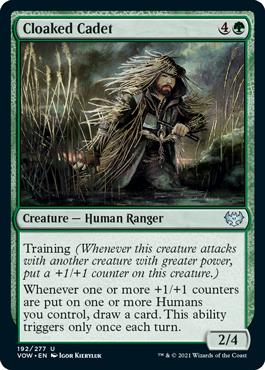
Cloaked Cadet is a less all-in payoff that’s mediocre on its own but exciting if you can have it witness other creatures being trained.

Laid to Rest is a pretty all-in card. it makes combat and removal spells play much worse for your opponent If your creatures are mostly humans, but it’s a 4-mana do-nothing if not. The lifegain is a small but also appreciated bonus.
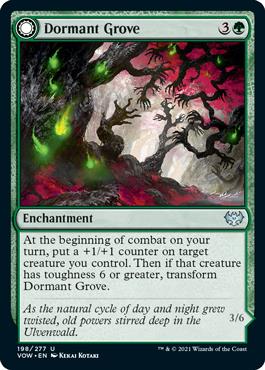

Dormant Grove and Angelic Quartermaster are strong cards on rate that play well with +1/+1 counter synergies.
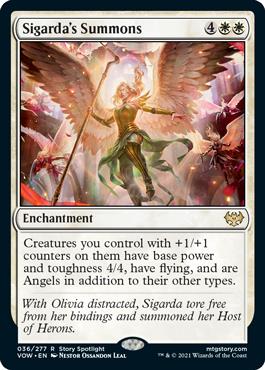
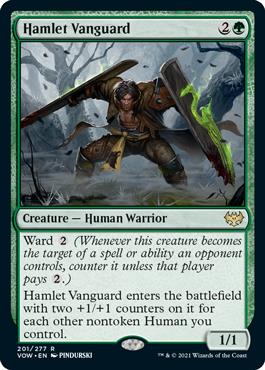
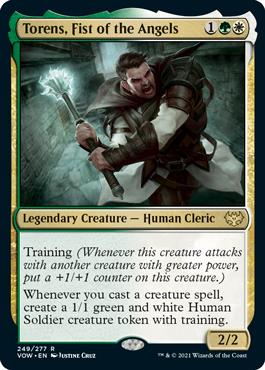
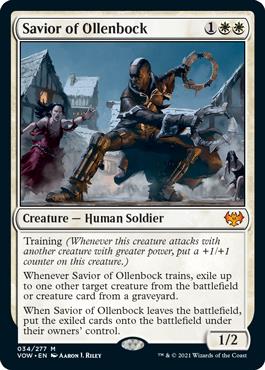
Sigarda's Summons, Hamlet Vanguard, Torens, Fist of the Angels, and Savior of Ollenbock are some of the best rare payoffs for an optimal Selesnya deck.
Overperforming Commons


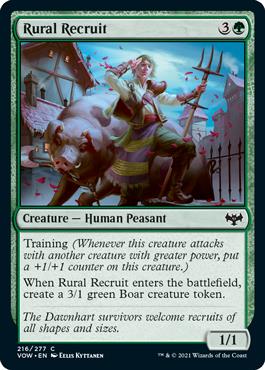

If you’re going for a synergistic Selesnya deck, prioritizing training creatures makes sense. Gryff Rider and Apprentice Sharpshooter are my favorite ones at common, but I also wouldn’t cut Rural Recruit or Parish-Blade Trainee from my average Selesnya deck.
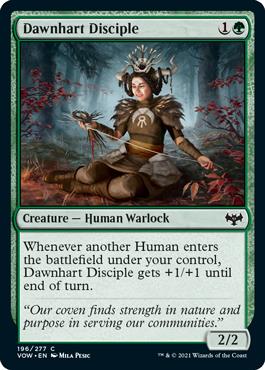
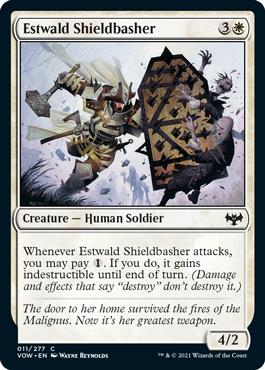
Dawnhart Disciple and Estwald Shieldbasher both deserve honorary mentions as being better in Selesnya relative to other decks that could play them. Disciple plays well with Selesnya's many humans while Shieldbasher is great for training up smaller creatures.


Adamant Will and Bramble Armor also overperform a bit in Selesnya, but cards like this tend to wheel during a draft so you shouldn’t prioritize them. 17 or 18 creatures plus a few support or removal spells is a good balance!
Trophy Example

Playing Against It
Cheap removal like Gift of Fangs, Piercing Light, Fear of Death, and Abrade excels at disrupting otherwise powerful training curve outs. Timing is essential against Selesnya since you can pump spells in their hand with good timing or force your opponent to train into open mana and re-trick their pump spell for value.
Crushing Canopy can also be useful against certain Selesnya builds since two of their dedicated payoffs (Laid to Rest and Sigarda's Summons) are destroyed by it.
Enemy Color Archetypes
Each of the five enemy color supported archetypes in Crimson Vow has a build-around theme. There’s less support for these color pairs than the other five archetypes, so expect to fill your deck with generally good commons and splash a bit more often.
Orzhov Life Gain
This is easily my favorite of the enemy-colored archetypes and also my most successful in general. Orzhov is a midrange deck that can generate value while gaining an absurd amount of life. This dual gameplan works well against both aggressive and controlling opponents since Orzhov also has the best hard removal against various bomb rares in the format.
Best Payoffs
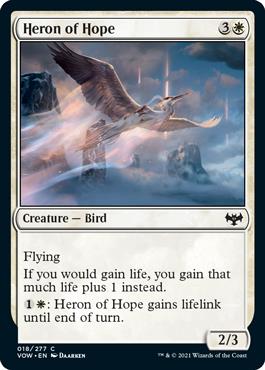
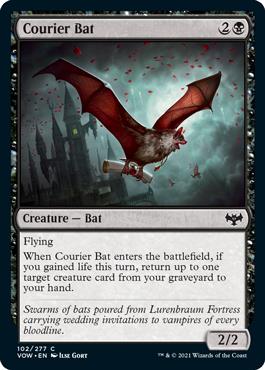
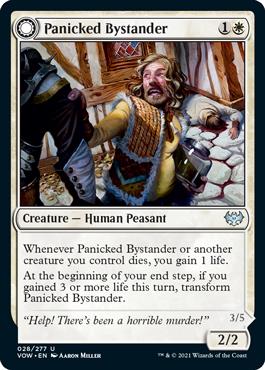

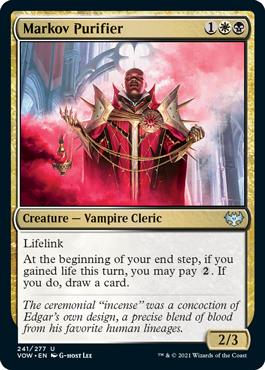

Heron of Hope, Courier Bat, Panicked Bystander, Restless Bloodseeker, Markov Purifier, and Voice of the Blessed are all of the cards that reward you for gaining life. That’s not a huge cast of characters, but two of them appear at common and many of the cards you use to gain life are just plain good on their own. Purifier is definitely the best non-rare reason to be Orzhov.
Overperforming Commons


Heron of Hope and Courier Bat are lifegain payoffs and play well in Orzhov.



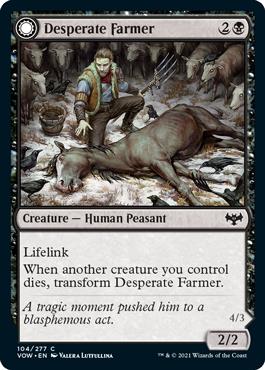
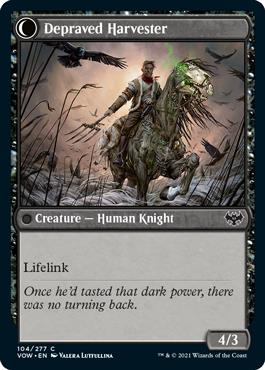
The best commons for gaining life without playing bad cards are Traveling Minister, Kindly Ancestor, Gluttonous Guest, and Desperate Farmer.

Pointed Discussion is another card that has overperformed for me in Orzhov since the life loss is easily offset by Orzhov's other commons.


Ragged Recluse is worth a mention as a card that certain Orzhov builds seek out but others avoid playing. Whether or not you want it mostly depends on how many Gluttonous Guests and Pointed Discussions you end up playing.
Trophy Example
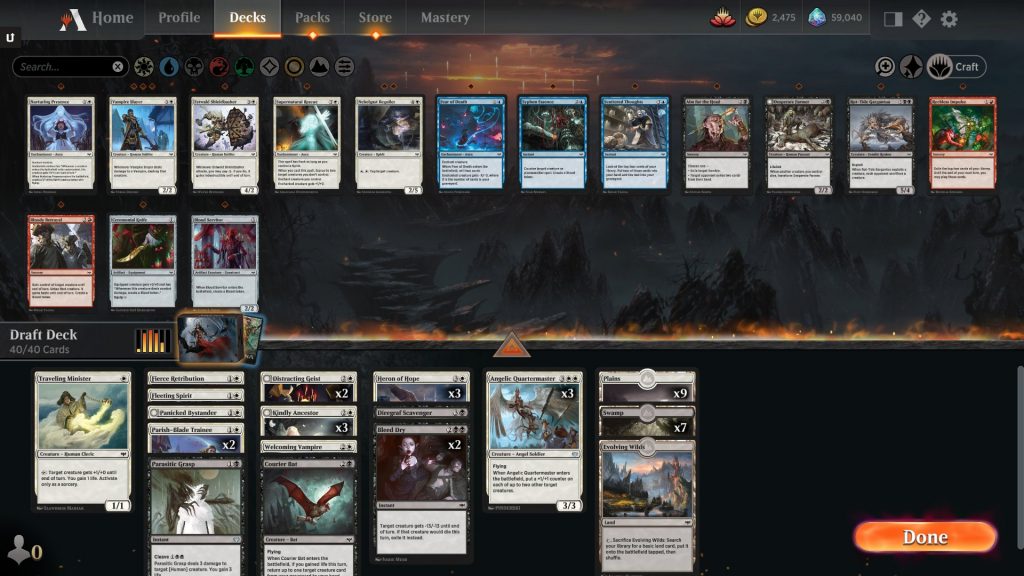
Playing Against It
Killing Markov Purifier is often step #1 to beating Orzhov. Orzhov can struggle to generate value if they don’t have it in play, but Blood Fountain and Courier Bat returning Purifier is definitely a risk.
There’s no easy solution here but having answers to fliers generally takes away Orzhov's cleanest way to actually win games.
Golgari Butts/Midrange
Golgari has a light but very fun theme that revolves around playing creatures with high toughness for various payoffs. Headlining this theme is the otherwise embarrassing Unhallowed Phalanx, which can be a 13/13, 13 damage to the face, +13 life from a Flourishing Hunter, etc. But because these payoffs are mostly uncommons, not all Golgari decks lean particularly hard into this theme.
Best Payoffs

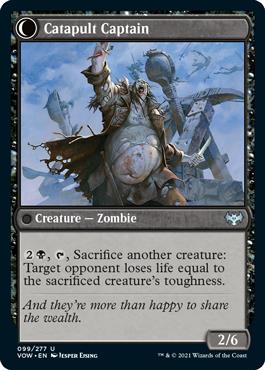
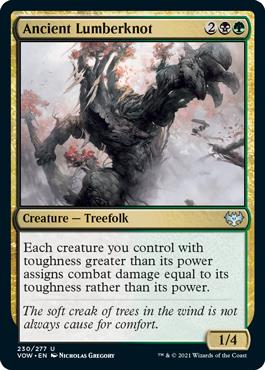

Catapult Fodder, Ancient Lumberknot, and Geralf, Visionary Stitcher are the best payoffs for the “cares about butts” (don’t we all?) deck. Lumberknot is particularly appealing because it’s a 4/4 for with small upside at worst, even if you don’t play any copies of the 1/13. Fodder is the most explosive payoff and a passable card in most decks. Geralf, is a blue card but still worth noting because a dedicated Unhallowed Phalanx deck should absolutely splash it.

If you aren’t doing the toughness theme, prioritize normal bomb rares, efficient creatures, and Bleed Dry. Honestly, prioritize these things in addition to the toughness theme.
Overperforming Commons

Flourishing Hunter is definitely worth prioritizing in Golgari. It’s a big beefy creature that also functions as nightmare fuel for aggro decks alongside Unhallowed Phalanx.

Apprentice Sharpshooter is another common I almost never cut from any Golgari deck since it has high toughness and a crucial reach ability.




Because of how light Golgari's theming is, Weaver of Blossoms, Nature's Embrace, and Honored Heirloom generally overperform in Golgari.
With black having the best removal and green having the best mana fixing, BGX is one of the best bases for a 4- to 5-color good-stuff deck.
Trophy Example

Playing Against It
If your opponent is trying to go off with Ancient Lumberknot and Catapult Fodder, the easiest way to deal with them is simple: kill their payoffs. The average Golgari deck won’t have redundancy for these effects and you can just fly over their now-worthless Unhallowed Phalanx until they yield to your awesome might. Flying in general is just very good against Golgari.
Izzet Spells
In classic Izzet fashion, it once again revolves around casting instants and sorceries for various payoffs. What makes Izzet unique in Crimson Vow is that all of the payoff-themed cards in this set say “non-creature” (like prowess) instead of “instant or sorcery.”
This slight buff makes artifacts and enchantments play a bit better in Izzet than they would otherwise, but most Izzet decks still focus on creatures plus instants and sorceries. Izzet is best built aggressively since truly controlling Izzet decks lack long-term answers to this format's many problems.
Best Payoffs
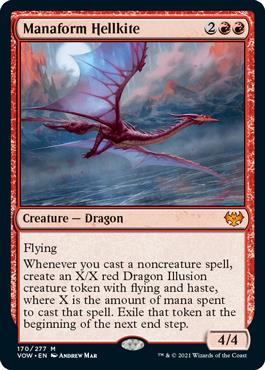
The non-creature theme isn’t especially deep in this set. The best of these payoffs is Manaform Hellkite, a 4/4 flier for with tremendous upside.
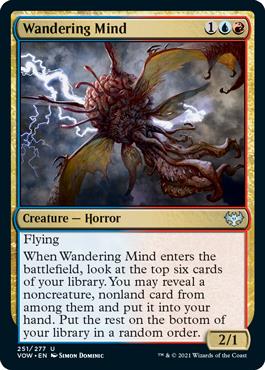
Busted mythics aside, Wandering Mind is the best other card as a 2/1 flier for with a very high chance to replace itself. Top 6 is slightly over 80% to hit even with just 9 hits.
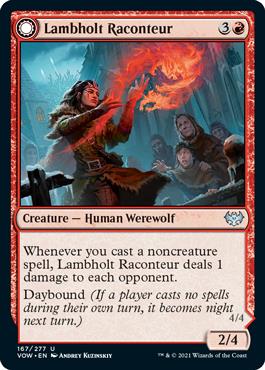
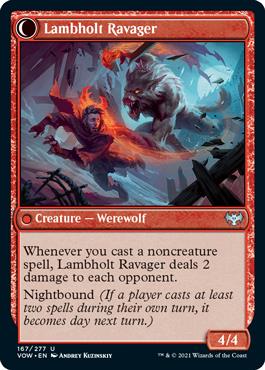
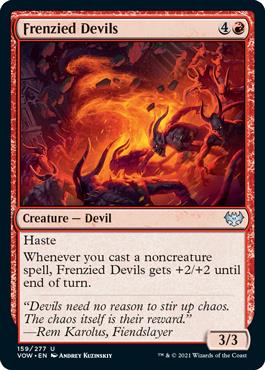
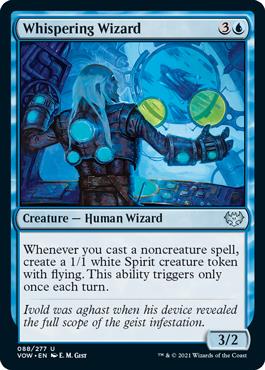
Lambholt Raconteur, Frenzied Devils, and Whispering Wizard are fine rewards for being Izzet, but none of them are amazing either.
Overperforming Commons
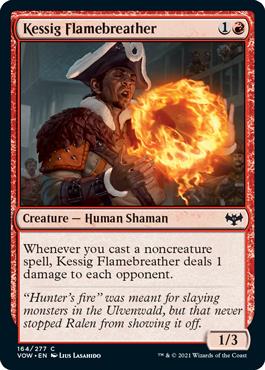
Kessig Flamebreather has definitely overperformed. 1/3 sizing on a 2-drop is less disappointing than usual thanks to it blocking good 2-drops like Drogskol Infantry, Blood Petal Celebrant, and Sporeback Wolf, and the 1-damage trigger is definitely relevant. The card is also unpopular in non-Izzet archetypes and great in multiples if you can get them.

Cruel Witness is also at its best in Izzet, though I’d prioritize cheaper cards over 4-drops.
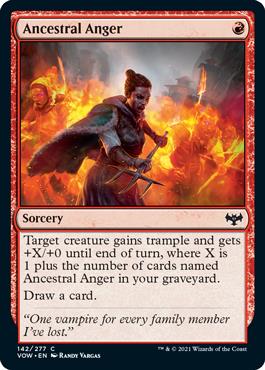
One card worth noting in the context of Izzet is the so-far unmentioned build-around common, Ancestral Anger. Izzet is the best home for this common and you can deal crazy amounts of damage out of nowhere if you can get 3+ copies of it. Anger goes very well alongside Flamebreathers, Frenzied Devils, and other cards you’d expect Izzet to prioritize.
Trophy Example

Playing Against It
Games against Izzet can snowball quickly in the Izzet player's favor if you leave an opening for them or run something important into a timely counterspell. Not stumbling against Izzet is key since giving them an early damage lead really improves their counterspells and Ancestral Anger game plan.
Orzhov has excelled against Izzet for me since most Izzet decks just can’t deal 30+ damage in one game!
Boros Aggro
Boros is generally the fastest deck in the format. It doesn’t have too much synergy beyond Daybreak Combatants plus training or creatures plus your opponent’s face, but that doesn’t mean the deck isn’t viable.
Best Payoffs

Markov Waltzer is a great signpost uncommon for this archetype and one of the few hard reasons to be Boros. The other Boros cards in the set, Lantern Flare and Odric, Blood-Cursed are mild incentives at best.



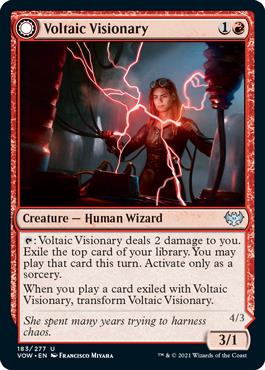
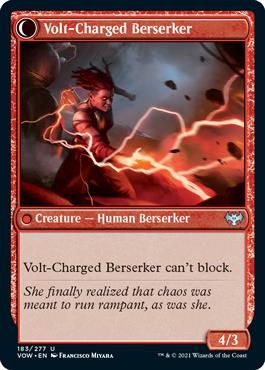
The best Boros cards are just the best red and white cards in general. Top uncommons like Angelic Quartermaster, Valorous Stance, Voltaic Visionary, and Rending Flame excel here.


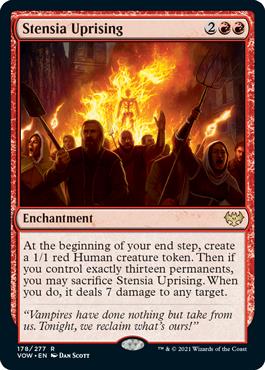
As for rares, you’ll ideally have great bombs like Wedding Announcement and Stensia Uprising, but they’re by no means necessary.
Overperforming Commons





Daybreak Combatants is at its best in Boros, but it should still be picked lower than better 1- and 2-drops like Traveling Minister, Drogskol Infantry, and Blood Petal Celebrant.

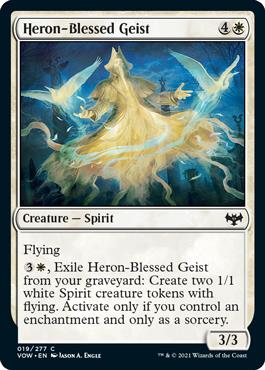
Fliers like Gryff Rider and Heron-Blessed Geist have also performed well since evasion is key for closing out games where you get outsized in the crowd.
Trophy Example
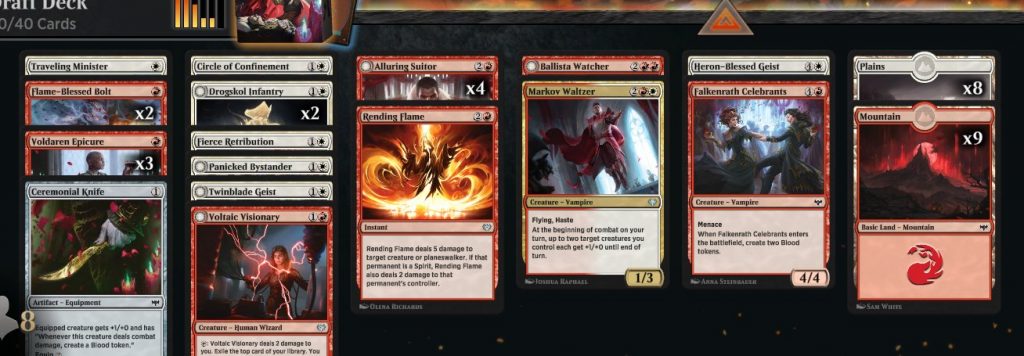
Playing Against It
Like against Selesnya, this is the best matchup for you to board in cards like Gift of Fangs, Piercing Light, and Fear of Death that may not have made your main deck. Crushing Canopy can also be good if Markov Waltzer is giving you problems.
Keep your life total high and play towards going over the top of Boros if you’re more controlling or try to create an early opening if you’re another aggressive deck. Boros is terrible when behind. If your Boros opponent happens to have bomb rares that are individually problematic, try to balance boarding in answers like Crushing Canopy for Wedding Announcement or Stensia Uprising while keeping your curve leaner.
Simic Self-Mill
Simic is themed around filling its graveyard with creatures to work towards various payoffs like Vilespawn Spider and Moldgraf Millipede. It’s generally the control deck in most matchups since it needs time to set up.
This has been a personally disappointing archetype for me because the payoffs aren’t amazing and there isn’t a ton of redundancy for enabling it either. Decking is also a legitimate concern since Simic only has so many threats and doesn’t always have recursion if it mills them.
Best Payoffs
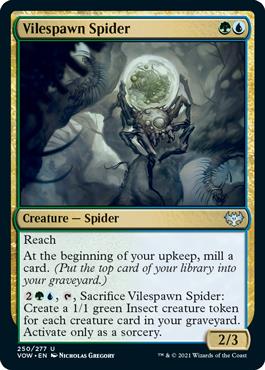
Vilespawn Spider is one of Simic's premier payoffs. What makes Vilespawn so compelling is that it isn’t just a payoff; it’s also an efficient blocker early and slowly creates card advantage by milling yourself each turn.
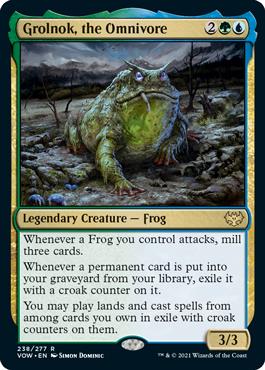
Outside of the Spider, Grolnok, the Omnivore is another self-mill payoff that safely draws you a ton of cards provided you can self-mill with it out. Grolnok does punish you for milling non-creature spells, though, so try to keep a high creature density with it. Or with Simic in general, really.

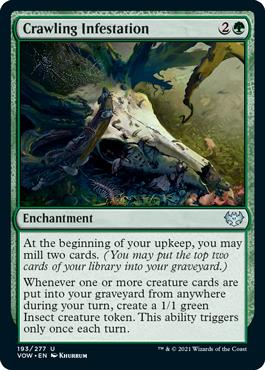
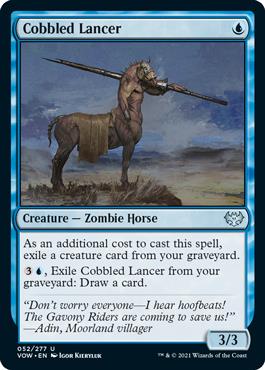
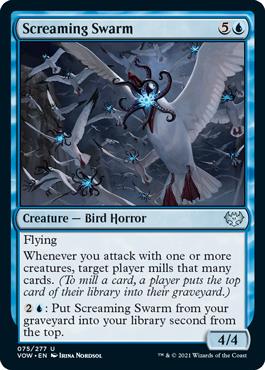
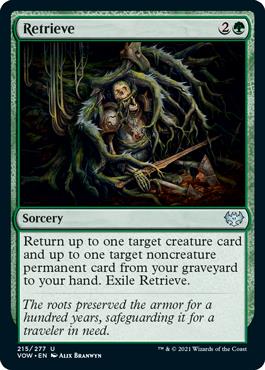

Other cards that are on theme for Simic are Bramble Wurm, Crawling Infestation, Cobbled Lancer, Screaming Swarm, and Retrieve. Reclusive Taxidermist also gets a shoutout for being in this theme, but it’s really just a great card in general.
Infestation is the only one of the Simic cards I mentioned that I’d hate to play since it has dramatically underperformed each time I’ve tried it. It’s incredibly slow, decking is a real concern, and the 1/1s rarely pull their weight in most Simic builds.
Overperforming Commons

Mulch is essential if you’re trying to make self-mill Simic work since it’s a great way to fill your graveyard with creatures while hitting your land drops.
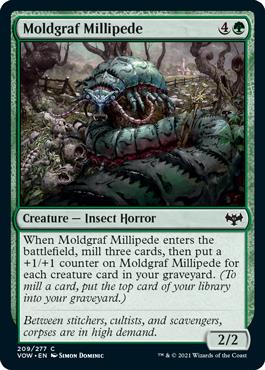

Moldgraf Millipede and Skywarp Skaab have obvious rewards for filling your graveyard with creatures but they conflict with each other.




Binding Geist and Lantern Bearer overperform in Simic since milling them to other cards is free card advantage.




Weaver of Blossoms and similar fixers overperform in Simic because it’s one of the most likely archetypes to splash other colors. It often needs to because its removal options are limited to just Wolf Strike and Fear of Death, neither of which are ideal.
One last point I'd like to add on Simic is that a high creature density is important for your payoffs like Vilespawn Spider and Moldgraf Millipede. Filling your deck with too many noncreature spells dilutes the power bump you will get from casting cards like Mulch. You'll still want to include some noncreature spells for removal/filling your graveyard, but try to cut medium noncreature spells like Massive Might and Alchemist's Retrieval for more creatures if you can. There is even some statistical data suggesting that UG's win rate climbs up as your total # of creatures increases!
Trophy Example

Playing Against It
Orzhov Lifegain stands a legitimate chance of simply decking Simic if they cast too many Mulch-, Moldgraf Millipede-, or Crawling Infestation-style cards. Outside of this funny corner case scenario, you can take advantage of how Simic is sluggish yet generally incapable of answering large creatures or most bomb rares.
Counterspells can also be effective if your opponent leans too hard on Moldgraf Millipede or Flourishing Hunter to win games.
Niche Decks
Grixis Steal + Sac
Bloody Betrayal is a very rarely played card in this set since Rakdos as a color pair doesn’t have any other real incentives to play exploit cards. Many exploit cards are also too expensive for Bloody Betrayal + exploit combos to be realistic to pull off in most games.
If you want to make use of those Betrayals that always seem to table in draft, then maybe you could consider pairing it with Mindleech Ghoul, Skull Skaab, Stitched Assistant, Fell Stinger, Geralf, Visionary Stitcher, Anje, Maid of Dishonor, etc. Basically any exploit/sacrifice effect under three mana should be practical enough. This lends towards Rakdos and Grixis () decks, though my example decklist is Savai ().
Trophy Example
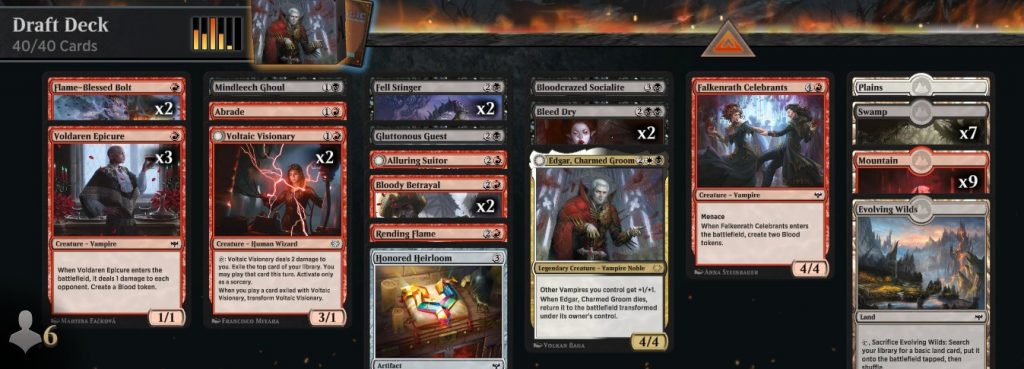
4- to 5-Color Good Stuff
Simple, honest Limited here: open bombs, get passed bombs, then decide that leaving a Wedding Announcement or Halana and Alena, Partners in your sideboard is a crime against humanity. If you prioritize fixing, blockers, and cheap removal, you just may yet live to cast four different colors of broken rares in the same game!
A picture is worth a thousand words, so check out my example below. I’d ideally have been a bit more base green since I skimped on Forests with only six and occasionally struggled to cast Weaver of Blossoms on turn 3.
Trophy Example

UGX Werewolves/Tempo
This is a rather niche deck that’ll probably come together once in every 100 or so drafts. Simic is one of my least favorite and unsuccessful archetypes, an opinion shared by many players. So you might find yourself in a spot where you’re base Simic thanks to rares and powerful cards but don’t have the right cards to power a self-mill theme.
You could try to use blue instants for bounce, counterspells, and draw with green beaters to play a tempo game rather than durdle and deck yourself out like Simic usually does. While such a deck wouldn’t have to play werewolves, it’s worth noting that they play excellently with Instants which Gruul is ill-equipped to take advantage of in this set.
I unfortunately don’t have a trophy example for this one, but maybe another player out there does!
If you want a great source for limited trophy decklists, be sure to follow Draftsim's account Limited Decklists on Twitter.
Wrap Up
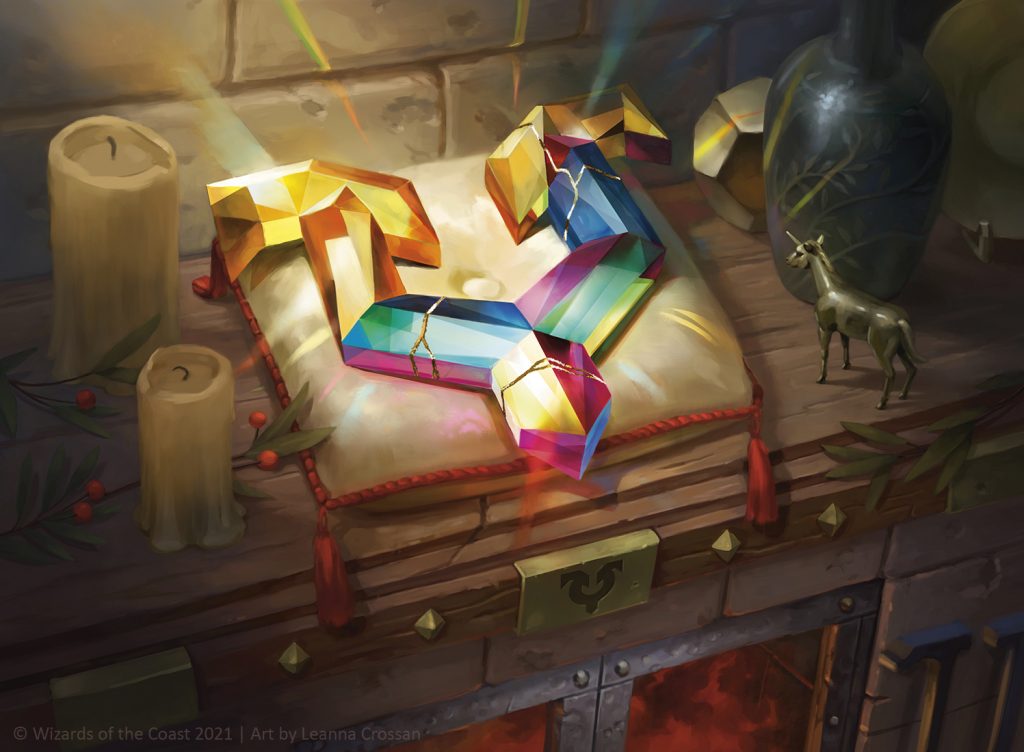
Honored Heirloom | Illustration by Leanna Crossan
Whew, that was a lot to cover! By the time you’ve finished, Olivia, Crimson Bride and Edgar, Charmed Groom should already be heading home on their Honeymoon Hearse. That’s okay though, as you’ll hopefully see them again this weekend in your rare slot at the Arena Open this weekend.
If you’re looking to get in some practice games before the big day, make sure you’ve got Arena Tutor by your side to make the absolute most out of your games. It is going to help you tremendously during drafting and for tracking your opponents' cards for BO3. Best of luck!
Follow Draftsim for awesome articles and set updates:
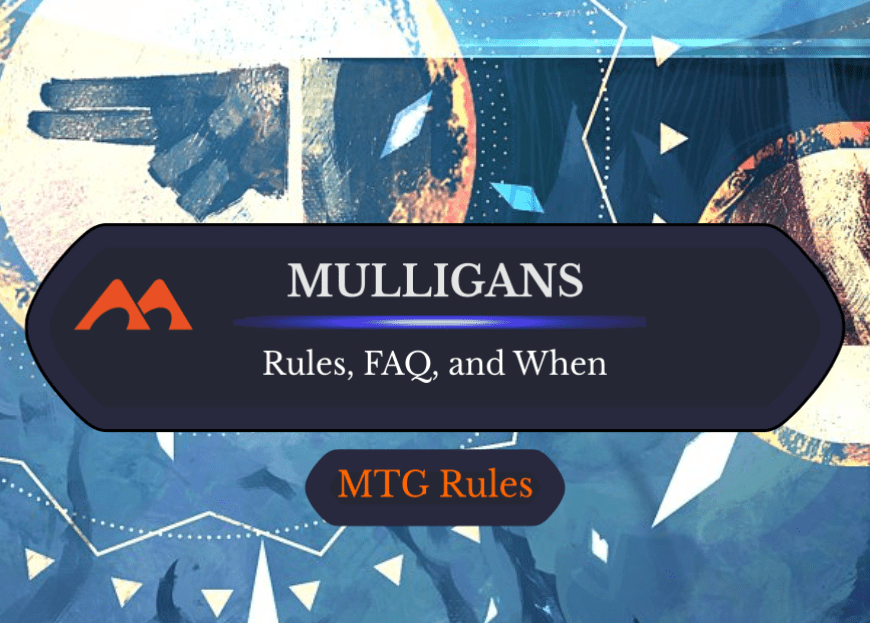
4 Comments
You missed rending flame in red
Good catch, added it to the article with a small blurb about it being a strong removal spell.
thanks for all the work! good guide
Absolutely, thanks!
Add Comment